Cast iron solutions that contribute to the comfort, safety and durability of buildings

SAFE AND SUSTAINABLE BY NATURE




For 150 years, we have been designing, manufacturing and supplying high-quality drainage systems for residential and commercial buildings and engineering structures.
We work exclusively with cast iron, a noble and durable material, of which we are a specialist and leader.
> As a leading manufacturer, we claim excellence in our processes, products and services.
> As a responsible manufacturer, we are at the forefront of sustainable performance to ensure we make the world a better home.
> As an innovative manufacturer, we put all our creative audacity into developing new, more specific and more efficient technologies, to deliver better products for your future needs.
PAM Building, a company built on the strength of its people, established in 3 major countries: France, England and Germany, and servicing the world

Over 360 employees
Sales in more than 50 countries
2 manufacturing sites for our products: Bayard sur Marne in France Telford in England
1st business in the cast iron industry to have published a third-party validated Environmental Product Declaration (EPD)

+38 : our indicator « Employee Net Promoter » that reflects the number of staff willing to become Ambassadors of the company (on a scale of -100 to +100)
35% female managers
1/3
internships and workstudy contracts converted to full employment contracts
As a member of the Saint-Gobain Group, a 350-year old world leader in providing innovative and sustainable construction products
168,000 employees and over 100 nationalities represented
10,000 production sites worldwide
An industrial presence in 75 countries
CAST IRON, A MATERIAL WITH AWESOME CARACTERISTICS
FIRE SAFETY
ACOUSTICS
DURABILITY
CHEMICAL RESISTANCE
PRODUCTS THAT ADAPT TO THE CONSTRUCTION CHALLENGES OF TODAY AND TOMORROW
SOLUTION PRE-ASSEMBLY
ELIXAIR® Earth-to-air heat exchanger


OUR MANAGEMENT SYSTEM FOR QUALITY, ENERGY AND ENVIRONMENT CONTRIBUTES TO THE CONTINUOUS IMPROVEMENT OF OUR ACTIVITY
9001 14001 50001
For PAM Building, being committed to sustainable development actions by ensuring its plants’ full compliance with current regulations is just the start.
Plants in the metallurgical industry call for greater vigilance and strict compliance with instructions, as the risks of serious accidents are particularly high.
The comprehensive approach adopted led us to obtain the ISO 9001, ISO 14001 and 50001 certifications for our plants and also recently BES 6001 for Telford site.

COMMITTED TO REDUCING OUR IMPACT ON THE ENVIRONMENT
Our 2025 objectives vs 2010
Our commitment to reduce C02 emissions by 2030:
- 80% vs 2017
-40% CO2 (SCOPE 1 & 2)

-84% NON-RECOVERED WASTE

-97% DISCHARGED WATER

COMMITTED TO THE SAFETY AND DURABILITY OF BUILDINGS

Our cast iron solutions and systems help ensure the comfort, safety and durability of the most demanding residential and commercial buildings.
Their exceptional characteristics allow them to contribute to HQE, BREEAM, LEED and other international environmental certifications...


> High-rise buildings

> Hotels
> O ces
> Hospitals and Health Centers
> Cultural buildings
> Structures dedicated to leisure
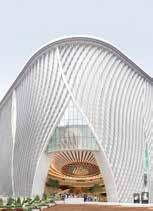
> Railway stations and airports


Our corporate culture attracts and develops the talents of the people in our teams over time.
We forge the technical competence that pushes us to the forefront of everything we do.





PAM Building believes in youth and proves it by integrating young graduates, its practice of apprenticeship and development.

Our commercial approach transforms us into providers of technical solutions to exceed our customers’ expectations.
Our team provides excellent service and technical support during the design, implementation of a project.
Our project managers ensure daily follow-up in the field to guarantee the best possible conditions for implementation.







Hotels are very special buildings since for a short time they act as a second home for the people staying in them. Customers therefore expect hotels to be restful and relaxing places. The higher the hotel is rated the higher the specifiers’ requirements for safety and comfort.
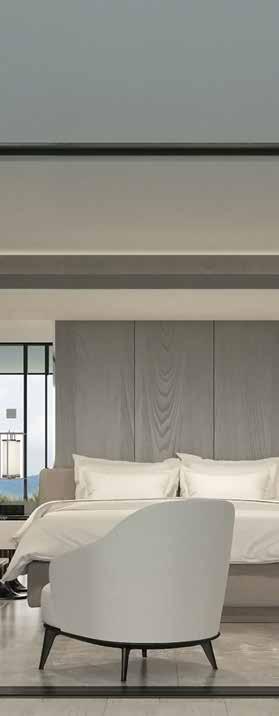
Wastewater and rainwater drainage systems are needed to maintain a peaceful and safe environment, requiring strong and durable materials, with minimal maintenance. Safe, totally watertight and silent in operation, the PAM cast iron drainage solution is the top choice for wastewater drainage systems in hotels.
Combining top-quality products and unrivaled longevity, the PAM cast iron drainage systems help maintain the sustainable and comfortable environment your building projects require.
CHEMICAL RESISTANCE
ACOUSTICS
FIRE SAFETY
DURABILITY



Rixos Tersane Hotel - Istanbul - Turkey
Premier Palace Hotel - Kyiv - Ukraine

City Of Dreams Mediterranean - Limassol – Cyprus
Sofitel Thalassa Hotel - Staoueli - Algeria
St Regis Hotel - Kula Belgrade - Serbia
Royal Mansour - Casablanca - Morocco
Jabal Omar Development Company, Phase 4 - Makkah - KSA

One & Only Aesthesis Resort - Glyfada, Athens - Greece
Ayia Napa Marina Villas - Ayia Napa Marina - Cyprus
Radisson Hotel - Bursa - Turkey
Sofitel Singapore City Center - Singapore - Singapore
Shangri-La Island Hotel - Honk Kong- China
Rixos Tersane Hotel - Istanbul - Turkey I S range

Premier Palace Hotel - Kyiv - Ukraine I S range
City Of Dreams Mediterranean - Limassol - Cyprus I S range
Capital Towers - Moscow - Russia
Lake View Residences - Tirana - Albania

Ziraat Bank Financial Center - Istanbul - Turkey

BADR Bank Headquarters - Algiers - Algeria
F Tower – Abidjan - Cote d’Ivoire

CFC Tower - Casablanca - Morocco
Trilliant - Tashkent – Uzbekistan
Central Bank of Azerbaijan - Baku - Azerbaijan
Kula Belgrade - Belgrade - Serbia
Downtown One - Tirana - Albania
Vodno Telecommunication Tower - Skopje - North Macedonia
Seef Lusail Residential Development Plots D3&D4 - Lusail - Qatar
Healthcare facilities have specific requirements that must be considered when designing wastewater drainage. Wastewater drainage systems in these buildings will face demanding operating conditions due to the types of e uents they carry, high operating temperatures and intensive use. In buildings dedicated to providing people with care, the pipe systems must meet more stringent requirements to maintain a safe and comfortable environment. To minimize the risk of ward closures or any disruption to medical care, the pipe system selected should require limited repair and maintenance.
E uents drained in healthcare facilities can be aggressive (especially from laboratories, etc.) and/or reach high temperatures (kitchens, laundry, etc.).


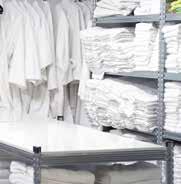
These characteristics must be addressed to protect the durability of the wastewater systems and avoid premature and costly repairs, liable to disrupt continuity of service.
The pipework is the building’s arteries, passing through structures - walls and slabsdesigned to contain fire.
In case of fire, the main risk for wastewater pipe systems, in addition to early collapse, is that they could fuel and potentially spread the fire.
Since a fire in healthcare buildings can have even more harmful e ects, careful selection of the pipe material is key to protecting both people and property.
In healthcare facilities more than anywhere else, noise is an unacceptable nuisance, disturbing the patients’ rest and the staff’s attention. Among the noises emitted within buildings, some stem from equipment including pipework flow noises and airborne or structure-borne noise.
The pipe sample (upper) and fitting sample (lower) were immersed for 30 days in di erent solutions widely used in hospitals in Europe for di erent purposes. The concentration and temperature were those recommended by the manufacturer. These severe tests aim to simulate accelerated ageing.

No damage was observed after the tests either on the PLUS pipe or the PLUS fitting samples.

Acıbadem Hospital Atasehir - Istanbul - Turkey
Onassis Cardiac Surgery Center - Athens - Greece

CHU - Agadir - Morocco
Sidra Hospital - Doha - Qatar
Military Hospital - Tamanrasset – Algeria
Grange University Hospital - Wales - UK

CHU ABYME - Guadelouppe - France
Princesse Grace Hospital - Monaco
Bozüyük State Hospital - Bilecik - Turkey
Clínica Universitaria de Navarra - Madrid - Spain
Children’s Hospital - Helsinki - Finland
CHU Tangier - Tangier - Morocco
Acıbadem Hospital Atasehir - Istanbul - Turkey I S range
Onassis Cardiac Surgery Center - Athens - Greece I S & Plus ranges
CHU - Agadir - Morocco I S & Plus ranges

Santiago Bernabéu Stadium - Madrid - Spain
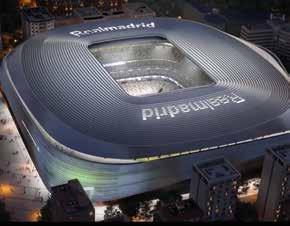

The Pyramid of Tirana - Tirana - Albania

New Atatürk Cultural Center - Istanbul - Turkey
Istanbul Museum of Modern Arts - Istanbul - Turkey

Berraki Stadium - Algier - Algeria
Arribat Mall Center - Rabat - Morocco
Grand Theatre Rabat - Rabat - Morocco
Kai Tak Sports Park - Honk Kong - China
Shaw Auditorium - Hong-Kong - China
11 Skies Commercial Complex - Honk Kong - China
UAE Pavillion EXPO 2020 - Dubai - UAE
Munch Museum - Oslo - Norway
Oasis Mall - Doha - Qatar
Santiago
The
Çukurova Airport - Mersin - Turkey
Domodedovo Airport - Moscow - Russia
Geneva Airport - Geneva - Switzerland
Hong Kong Airport Terminal 2 Extension - China
Muscat International Airport - MC 5 - Muscat - Oman
Athens Airport Extension - Athens - Greece
International Airport Terminal 3 - Frankfurt - Germany
Changi Airport Terminal 4 - Singapore - Singapore
Ahmad Yani Airport New Terminal - SemarangIndonesia

Ahmed Ben Bellah International Airport - Oran - Algeria
Manchester Airport Terminal 2 - Manchester - UK
Çukurova Airport - Mersin - Turkey I S range
Domodedovo Airport - Moscow - Russia I S range
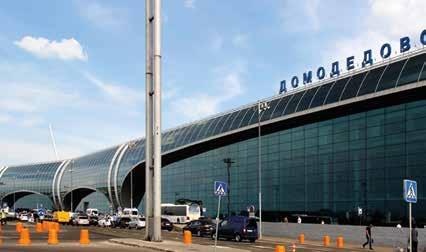
Geneva Airport - Geneva - Switzerland I S range - EPAMS®
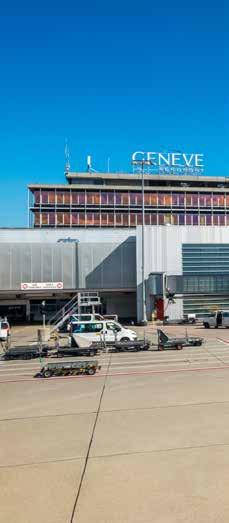
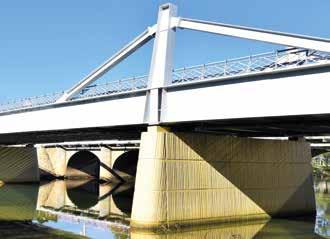
Dumbea Bridge - Noumea - New Caledonia
Central Greece Motorway E65 Bridges - Greece

TGV Train Station - Kenitra - Morocco

Athens Metro - Athens - Greece
Gayrettepe - Istanbul Airport Metro - Istanbul - Turkey
Eurasia Tunnel - Istanbul - Turkey
Cross Yarra Rail Tunnel - Melbourne - Australia
Mont Blanc Tunnel - Haute-Savoie – France
Tournon Viaduct - Savoie - France
Kula Vodno - Skopje - North Macedonia
Doha Metro - Doha - Qatar
Step Project - Abu Dhabi - UAE




To help our customers define the most optimised network for EPAMS®, ITINERO® or ELIXAIR® systems, our technical support team designs solutions and provides drawings and bills of quantities.

You have a project to discharge rainwater on a flat roof and you want to quickly define the details and costs of the EPAMS installation (see also p.178).
Send us:
• Your drawings in DWG format (roof, levels, section views, etc.)
• The general rainfall intensity of your country (in mm/hr or l/s.m)
You will receive a response within 2 days concerning the feasibility and an initial design study*.
*Full studies are conditional upon the final order of the materials.
For our new dedicated range of bridges and tunnels (see p.76), we can support you with the system’s complete design.

Send us:
• The drawing of the bridge
• The drainage location (outlet and collector) in DWG format
We will provide you with:
• A design recommendation
• The discharge system’s set-up
• A bill of quantities
With global warming and the growing importance of energy e ciency, our earth-to-air heat exchanger ELIXAIR® system (see p.78) is becoming increasingly specified.
If you are asked to quote ELIXAIR®, send us your project and we will be able to help you with the supply of:
• Your earth-to-air heat exchanger
• The bill of quantities
• The heat energy saved in winter
• The cooling energy saved in summer
You have some doubts before finalising your quotation. PAM Building has set up a service for you.
Send us the drawing of the discharge system’s location with details of the pipe diameters in the following formats: DWG (preferred), RVT or PDF.

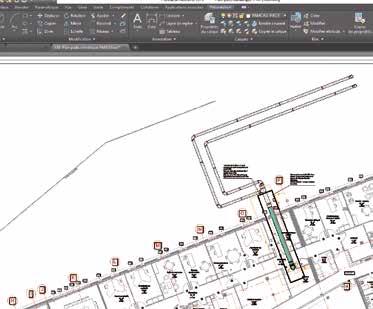
Based on general plumbing rules, we will provide you with the general bill of quantities including:
• The numbers of the parts
• The references to order

Our service portfolio is fully aligned with the new expectations of MEP consultants and contractors working on safe, comfortable and durable building projects.
In addition to our recommendations in this catalog, if you have any questions, you can ask our experts on the following topics:
• Acoustics (p.44)
• Fire protection (p.40)
• Technical and functional advice (see “Design & Recommendations” section)
• Environmental building certifications (p.63)
Drainage pipe systems are often considered utilitarian. As non-visible arteries, they are often poorly maintained and neglected in renovation planning, yet they can ruin the lives of the buildings’ occupants by causing major damage.
PAM Building therefore o ers a diagnostic service. The company has decades of experience which has resulted in:

• Creation of a database of the disruption and failures experienced on pipework systems
• Many requests for expertise because cast iron used to be the market’s technical reference
We can either perform the diagnostic ourselves (chargeable service) or train your teams to perform it, to avoid part renovation which brings further disruptions.
To help us provide professional services, we are equipped with:
• Hygrometer
• Temperature sensor
• Toximeter (measurement of hydrogen sulfide)
• Inclinometer
• Fluorescein
• Ultrasonic sensor
• Feedback
Upon request, PAM Building can provide special designs of fittings outside the ranges o ered in our catalog*. Send us your details and we will provide a response concerning the feasibility within two days.
The latest example is the 125 x 100 x 100 mm Double Branch, which is now available in our product range.
How does it benefi t the owner or maintenance team?
• Get a global picture of the wastewater and rainwater pipe systems

• Perform an audit of pipe discharge drainage
• Map and date the pipework, analyze the interactions and assess the condition
After diagnosis you will have a list of recommendations, with a view to guiding professional interventions, carried out in compliance with regulations and best practice.
For more information, contact us: tcbatiment.sgpam@saint-gobain.com Tel: +33 (0)3 66 74 00 89
PAM Building aims to ease the burden on developers, specifiers and contractors in the early stages of construction by providing two levels of BIM library and supporting information.
The new releases include a full-data objects library, a platform that provides supporting information and free individual BIM files for all products and systems.
These include an EN 877 “Generic Cast Iron” content package for use in the early design stages, with parametric model fittings, and standard geometric settings. The files contain only the most vital information, reducing the time and e ort required to create early stage plans. These “data-light” designs

can also be overwritten with the full data specification libraries without issue, speeding up later stages of development that require more detailed plans, streamlining the transition from design to as-built work flow.
PAM Building Libraries are designed to aid data transmission between the consultants and the Main Contract MEP design engineers, creating a leaner process that reduces design time.
By providing small file sizes for the generic content, it will facilitate early stage specification in BIM and speed up the whole planning process; this in turn will create measurable cost and time savings for our customers.

PAM Building has been developing BIM Level 2 libraries in Revit for its domestic use (S), siphonic rainwater (EPAMS®) and intensive use (Plus) ranges.



NEW REGISTRATION REQUIRED TO KEEP UP TO DATE WITH NEW/ REVISED CONTENT

FULL PARAMETRIC PIPE SYSTEMS GENERIC AND FULL DATA

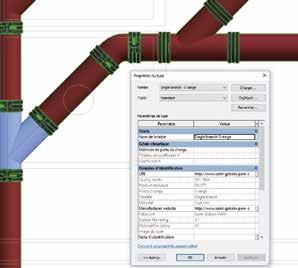
ACCESS TO GUIDANCE VIDEOS AND ‘HOW TO?’ FAQS

• Generic cast iron content
» Full range of cast iron fittings
» All families have ‘real geometry’
» Generic coupling with ‘fixing zone’ visibility
» All fittings have constrained couplings which can be turned on/o

» No ‘manufacturer’ data
» All files are light at 500 KB max
PAM CAST IRON LIBRARY
• Full data content
» Minor modifications to project design stages
» Time saving design for main contract BIM Engineers



With 150 years of experience in worldwide export sales, our international organization obtains all our customers’ feedback which we need to help us constantly improve our products and services. OUR CUSTOMER SERVICE TEAMS WILL BE HAPPY TO HELP!

To optimize its customer service, PAM Building has an integrated network of subsidiaries, agents and distributors which can rely on dynamic and experienced technical sales teams to provide excellent customer support.

For enquiries, our customer service is available from Monday to Friday from 8:30 am to 5:30 pm (French time): Phone : +33 3 83 80 76 50 / 53 / 54 Fax : +33 3 83 80 76 57
You can also find the contact details of our sales area manager on our website.
Every day, PAM Building ships a wide range of products to provide its customers with complete, operational solutions wherever they are. Depending on your needs and practices, you can either manage the transport yourself or we can quote you in accordance with the Incoterms you wish to contract with us. To speed up the process, we have signed an agreement with French Customs.





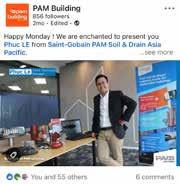











In our YouTube channel, you find installation tutorials of cast iron pipes, fittings and couplings, as well as informations about products, BIM service, production facilities, news and commitments.





As a leading manufacturer and the world’s top-ranking exporter of cast iron pipe systems for building drainage applications, PAM Building is an essential partner for wastewater and rainwater drainage system designers. PAM Building cast iron products are safe, easy to install and e ectively meet project managers’ requirements. We provide di erent ranges to suit all building types and specifications.
Cast iron products for building drainage systems are made of an alloy : iron, carbon and silicon. Cast iron is manufactured entirely from recycled raw materials: scrap iron and cast iron which are enhanced by a second melting process.
PAM Building cast iron combines the traditional longevity of iron with outstanding technical and mechanical properties which remain stable over time in all climates. Its robustness limits breakages and damaged supplies, and its nature and density confer thermal and acoustic properties guaranteeing safety and comfort in use.
• Quick standard installation with mechanical couplings assembled with simple tools, without gluing or welding, which can save time and labor costs.
• No expansion joints which facilitates the design and saves on expensive thermal limiters.

• No systematic fire protection or fire collars due to its fire behavior.
• Less protection for acoustic insulation due to its acoustic properties, resulting in plasterboard savings while achieving the same performance.
• Less embedment than other materials in buried applications where ground disturbance or extra loading is likely.
Cast iron has a proven 70-year lifespan due to its outstanding mechanical properties and safety margin in operation.
• Cast iron systems withstand cleaning operations, even at high pressure. They also withstand traditional unblocking chemicals and enzymes without damage: PAM Building is continuously carrying out research on its coatings to maintain such qualities.
• Cast iron in exposed sections of the drainage system, i.e. basement car parks, is more resistant to damage than other drainage materials. It is also less sensitive to cracks and breakage prior to installation.
• Cast iron below ground o ers greater resistance to ground movement, and is less likely to fail in unfavorable conditions.
With our networks, maintenance operations are limited.
• Cast iron drainage requires minimal maintenance during the lifetime of the building under normal conditions, making it the first choice for concealed, built-in or otherwise inaccessible systems, where repair or maintenance would cause major inconvenience to the occupants.
• Where necessary, removable mechanical couplings make repairs easier and cheaper without cutting into the stack. An extensive range of access parts provides ease of maintenance at vital points in the stack to relieve any blockages which may occur.
• In the event of destination changes in the premises or the addition of devices, the PAM systems, whose junctions are not glued or welded, can be modified without having to break or cut them, by simply removing the joints.

PAM Building pipe systems comply with European standard EN 877, applicable to a system (cast iron pipes and fittings, couplings and accessories for building drainage). This standard, specifying the technical requirements for cast iron products, is the most stringent in the market.
• Reaction to fire (product range)
• Resistance to internal pressure
• Dimensional tolerances
• Tensile strength, crushing strength
• Joints and their leak tightness
• Inner lining and external coatings and their suitability
It also defines test methods and the quality management system. Except for reaction to fire properties, EN 877 is a self-declared standard; the manufacturer is allowed to self-declare that their product complies with this standard.
Only compliance with EN 877, which is validated by a third party for all criteria and periodically tested, can guarantee the performance of the systems you specify.
The quality of product ranges is guaranteed by quality marks: Marque NF, RAL-GEG, Kitemark, BBA, Sintef, Gost, Q+.

Cast iron pipes and fittings, their joints and accessories for the evacuation of water from buildings - (Requirements, test methods and quality assurance)
Elastomer seals - Material requirements
Requirements for a quality management system design, product development, production, installation and after-sales support
Environmental management system - (Requirements with guidance for use)
Energy management system
Testing standards
Fire tests
Fire classification of construction products and building elements.
Classification using data from reaction and resistance to fire tests
Reaction to fire tests for building products - Part 1 Building products excluding floorings exposed to thermal attack by a single burning item
Measurement of noise
Laboratory measurement of noise from wastewater installations
European standards International standards
EN 877
EN 681-1
ISO 4633
ISO 9001
ISO 14001
ISO 50001
EN 13501-1
EN 13501-2
EN 13823
EN 14366
The European Construction Products Regulation made CE marking mandatory on products for which the manufacturer has drawn up a declaration of performance.
The CE marking indicates that manufacturers take responsibility for the construction product’s conformity with the declared performance as well as compliance with all applicable requirements laid down in the European Construction Products Regulation.
• To allow for free circulation of industrial products within the European Union and the European Economic Area
• To guarantee that these products are not dangerous to European consumers and users
• To have the same safety criteria shared throughout Europe
Fire safety was selected as the only essential requirement for the CE marking on wastewater products, which must be supported by laboratory tests conducted at recognized independent facilities. This led to a “Reaction to fire” classification in the Euroclass system.
Our cast iron drainage systems are manufactured to harmonised European standard EN 877 and have therefore required CE marking by law since July 2013. Although it is not a quality standard, the CE mark is a self-declaration of product performance with the exception of reaction to fire, which requires mandatory certification by independent tests at a recognised fire testing center.
The CE mark is NOT a quality mark but a self-declaration of product performance (DoP) in reference to its product standard (with the exception of reaction to fire which requires independent testing at a recognised fire testing center).
The CE marking on a product certifies that it complies with the harmonised part of the reference standards and is a minimum prerequisite for placing the product on the market.
Except for the reaction to fire class, the third-party certification of the performances is not guaranteed by EN 877, but by one of the following marks: Marque NF, RAL-GEG, Kitemark, BBA, Sintef, Gost, Q+.
Third-party certification not made compulsory by EN 877 Third-party certified
To comply with the CE mark, PAM Building cast iron drainage systems bear a quality mark to demonstrate the product’s standard:

• Our system complies with all of the standard’s clauses.
• We are periodically audited by a third party.
• This gives you the ultimate quality guarantee.
Choosing a complete and consistent range of cast iron products, whose assembly has been performance tested against regulatory requirements, provides you with peace of mind that few other materials can guarantee.

Pipes
The identification marking for PAM Building fittings is a label. Marking also identifi es the manufacturing site.

The plants which manufacture our products are certified for their compliance with the ISO 9001 standard which specifies requirements for a quality management system. The scope of this standard covers product design and development and the quality control of procurement, training, and administrative follow-up.

Drainage systems are the arteries of a building. In case of fire, there is a risk that pipes will maintain and spread the fire in the building. Pipe penetrations through a separating element like a wall or a slab are always a source of risk for the spread of fire to the adjacent room, the floor below or the floor above. As regards a building’s fire safety, the major responsibility rests with the project manager who must comply with local regulations. Accordingly, and particularly in high-risk buildings like high-rise
This is the instant behavior when a fire breaks out, its propensity to ignite or fuel a fire. This behavior is assessed on the basis of standardised tests and described in a Euroclass classification.
The Euroclasses are based on test methods and establish reaction to fire classifications that are harmonised throughout Europe. This means they can be used to compare materials and product performances.
buildings, materials with reduced flammability should be selected as a precautionary measure.
PAM Building is committed to the development of high-quality and high-safety products. Fire safety is one of the main technical performances of our products. In choosing PAM Building cast iron systems, you are guaranteeing the safety of both people and property.
There are two concepts applied to fire safety: reaction to fire and fire resistance.
EUROCLASSES
Classes
s1: Low smoke production
s2: Medium smoke production
s3: High smoke production
FLAMING
d0: No flaming droplets
d1: Flaming droplets that persist for less than 10 s
d2: Flaming droplets
PAM Building cast iron systems are among the safest materials on the market in terms of reaction to fire, and all its drainage systems have been tested independently to the stipulated test criteria.
In tests carried out by the CSTB accredited laboratory, the PAM Building cast iron ranges (pipes, fittings and accessories, including elastomer gaskets and coatings) received the following excellent Euroclass ranking: A1 for our standard “S” range and A2-s1, d0 for the “Plus” range.
Scope
The CE marking for cast iron wastewater systems is based on the harmonised standard EN 877, which applies to a system including pipes, fittings, couplings and accessories, and is used to test all of the ranges’ components.
The classification obtained by PAM Building covers complete ranges: pipes, fittings, couplings and accessories that are components of a wastewater pipe system.

Check the reaction to fire classification of the products you specify, and ensure the tests were carried out by an accredited testing centre. This compliance is validated by complete quality marks, is periodically tested by accredited third-party laboratories and provides you with a performance guarantee for the systems you specify.
→ A1 Euroclass Rating for the S Range –it is completely non-combustible!
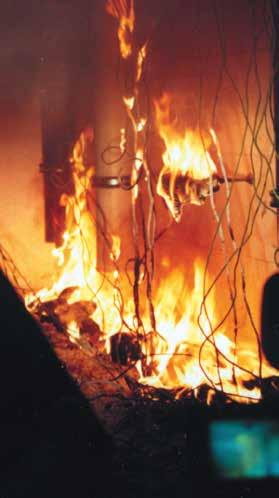
→ No smoke and no flaming droplets in the event of a fire.

Cast iron remains one of the best materials when it comes to fire safety.
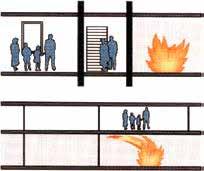
This is a construction component’s ability to withstand fire for a given period of time and to retain its serviceability in the event of fire, avoiding the spread of fire. If a fire breaks out, it is essential to prevent any early collapse of the structure, and then limit the extent of the damage to ensure that occupants can be evacuated and/or belongings will be protected. Many buildings are not su ciently protected against fire hazards. This means that fire can spread quickly, destroy the building in a short time and, more importantly, endanger the lives of the occupants. When a fire breaks out, the first objective is to slow down its spread both horizontally and vertically.
The main causes of fire are:
• Faults in electrical systems
• Human error
• Overheating
• Arson
Lightning strikes or explosions play a minor role in the statistics here, but can lead to a chain reaction of fires if they do occur (Source: www.ifs-ev.org).
The fire resistance performance level will be influenced by a number of factors: the pipe diameter, the thickness of the floor or wall, the size of the penetration void, the material used to seal the void and even the stack configuration through the penetration.
When they exist, fire safety regulations for buildings are based on a compartmental principle. Within a building, a compartment is a fire rated space designed to stop the fire for a given period of time. The fire stopping requirement for walls (shells and slabs) is generally 2 hours or less - and exceptionally 4 hours.
The requirement depends on the type of building and its level of occupancy, and can be very different from one country to the next.
Drainage systems passing through structures designed to withstand fire should not provide open breaches. For a given time, specified in the applicable regulations, they should not allow the passage of fire, smoke, heat or combustion products from one compartment another.
Cast iron, a non-combustible material, has a melting point of over 1000°C. In most cases it requires no additional fire protection.
PAM Building has and will continue to periodically test its cast iron drainage systems with standard mortar penetrations and other solutions in order to understand the potential e ects of fire on its integrity, resistance and overall performance. We carried out a non-exhaustive series of tests to o er precise guidance for fire resistance.
Our systems proved to meet integrity and insulation requirements up to 240 minutes (4 hours)*, and should therefore not collapse causing potential danger to evacuating people or firefighters.
We regularly perform new tests. Therefore, if you have any questions our technical team can provide guidance and help you select the right configuration for optimal performance and provide you with a comprehensive report. You can contact our technical support team on our website: www.pambuilding.com.
For plastics, the fi re stopping rule consists in “plugging the hole”. This function is achieved by using fire collars recommended by the manufacturers. Plastic materials, which are highly sensitive to heat, will not withstand fire, and will not remain in place, even in the case of a contained fire. As shown by laboratory tests in Germany, if the fire collars are not activated, particularly when installed under the fire compartment, they significantly increase the risk of the fire spreading downwards in a multi-storey building. When some types of plastic material (e.g. HDPE and Polypropylene) are exposed to fire they generate molten droplets, which could potentially spread a fire down through the building.
Exposed to fire, plastic material releases toxic fumes and gases, which beyond a certain amount may be fatal to the people inhaling them.
* Furnace tests carried out in 2017-2018 according to EN 1366-3 at the EFECTIS testing centre, the European leader in fire science, engineering, tests, inspection and certification.
Choosing PAM Building
cast iron drainage systems guarantees the safety of both people and property.
Noise in buildings is considered to be detrimental to health and quality of life. Efforts have been made in the last 30 years to attenuate the sounds coming from the street, worsening the perception of sounds emitted within buildings. Heat insulation policies aimed at reducing energy consumption will also heighten these perceptions. Among the priority criteria in the comparative performances of drainage materials, acoustic performance is considered to be second only to fire safety: cast iron pipe systems have intrinsic acoustic properties. Owing to the development of equipment accessories, they offer outstanding performances.
Noise from wastewater pipe systems is classified in the regulation under “equipment noise”. Noise originating from pipe systems is due to the sound energy produced by water/ air turbulence, but mostly by the mechanical e ect of the water flow on the internal pipe walls. In such circumstances a pipe will radiate noise outward and transfer it to any lightweight ceilings, cupboards and similar areas wherever it makes contact.
Noise is an energy that a ects air pressure and is transmitted through vibration.
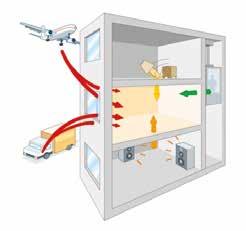
Sound is measured in decibels (dB) using a nonlinear scale. For equipment noise, the following categories are identified and measured:
Airborne noise:
Airborne noise vibrations that are propagated. In the case of wastewater pipe systems, this noise is mainly heard in the room where the pipe is located. When a material is dense and thick, the pipe walls prevent air-borne noise transmission, as is the case with cast iron which has intrinsic acoustic properties.
Structure-borne noise:
The vibration of a building’s structure. This noise will be noticed in rooms adjacent to the pipe. When the noise produced in a pipe is not transmitted by the air, the residual noise is transmitted by structural vibrations. Whilst the mass of the cast iron limits the vibratory level, the junctions and fixings to the building will propagate noise. Objective: dampen the vibrations at the connections to the solid structure.
Statutory requirements for “equipment noise” for structure-borne noise di erentiate between noisy rooms and quiet rooms with sound attenuation requirements. For noisy rooms, the noise level requirements are generally 35 dB or more. For quiet rooms, which are generally living rooms, resting rooms and work rooms, the noise level requirements are generally around 30 dB, in cases where noise regulations exist.
Acoustic comfort is a di erentiation criterion that indicates construction quality. The building project manager and specifier may define together specific requirements to improve the final construction.
In 2019, PAM Building commissioned a series of comparative tests on airborne and structure-borne noises in installation conditions described by standard EN 14366*, at the Fraunhofer Institute for Building Physics in Stuttgart.
The measurement results for the PAM Building cast iron pipes listed in the table were determined at the Fraunhofer Institute for Building Physics on an installation wall with a basis weight of 220 kg/m2

The prerequisite for this was that the building conditions in the real construction situation be comparable to or more favorable than the test bench of the Fraunhofer Institute for Building Physics in terms of sound technology.
When compared with the requirements, pay attention to the simultaneous operation of plumbing installations and possible interactions among the plumbing components which may produce di erent results. As a comparison value with the requirements, the measured value should be obtained at a flow rate of 2.0 l/s, because this corresponds to approximately one toilet flush. The sound measurements were taken both on the opposite side of the installation (in the picture on the right) and in the mounting room (on the left of the picture).
> Standard bracketing: 2 bracket collars per floor. Both mounted with a 1 Nm torque.
> Stack support: Stack supports are fixed to the wall/floor.
> PAM’Acoustic: 2 anti-vibration brackets per floor. Both mounted with a 1 Nm torque.
DG: Attic
EG: Ground floor In front
UG: Basement In front
The test results are on the next page


Tests results for the installations, according to EN 14366
Complete reports are available on request. Sound levels below 10 dB(A) are not mentioned in the test report.
For the requirements of extreme acoustic comfort (luxury buildings, auditoriums...), Pam’Acoustic is an acoustic dampener, which, placed between the frame and the support collar of the cast iron pipe, makes it possible to achieve the exceptional structural noise level of < 10 dB (A), that is, almost silence.



Usually pipe systems are installed in a technical shaft that contributes to reducing the noise emitted by the e uent flowing in a pipe. Nevertheless, the noise level of pipes installed behind a shaft may not be su cient to comply with the specifications of the owner or set by the national regulation.
In 2018, PAM Building initiated several noise measurement tests with an independent laboratory in real conditions, inspired by standard EN 14366, but using a real WC flush to assess the noise level of the combination of pipe material and shaft acoustic performance (∆Lan).
Below are some examples of measurements at a flow rate of 2 l/s with the S range fixed on a 15 cm thick supporting concrete wall:
SUMMARY OF OUR SOLUTIONS:
→ High basis weight
→ Low tendency to vibrate
→ Effective sound decoupling
→ High insulation value

→ Suitable for all pressures
→ Sewage installations
→ Precise installation instructions
→ Compliance with project specifications or regulations
Depending on your project specification or national regulation, PAM Building can help you validate your pipework’s compliance.
Please contact our technical support team on our website: www.pambuilding.com.
Choosing our systems guarantees the best acoustic solution on the market.
Pipe system components must withstand hazards before they reach the job site such as accidental impact before and during installation, during storage, handling and transit. In service, outdoor exposed pipes may be damaged by accidental impacts or vandalism. To avoid breakages, which can be expensive, or minor stress cracks which can have serious consequences in operation, the choice of material should be carefully considered.
Compared with other materials, cast iron provides much better impact resistance and is highly recommended everywhere pipes may be exposed to mechanical shock (car parks, streets, etc.).
Cast iron is well known for its robustness. The quality of PAM Building products is ensured by careful control of both the metal composition and the manufacturing process.
The spinning of pipes in the De Lavaud process, followed by heat treatment, gives these products outstanding mechanical properties.
The advantages of the De Lavaud process: better mechanical characteristics, superior to the requirements of EN 877*
• Very good resistance to crushing.
• Increased impact resistance.
• The pipe is more resistant to mechanical stress such as bending and compression.
• For installers, installation is more comfortable and on-site handling is facilitated. Cutting pipes is easier, the slices are sharp. The set-up is therefore simpler and faster.
In this process, a constant flow of molten metal at a perfectly controlled temperature and composition is gradually put into a steel mould rotating at high speed. The mould external wall is cooled by circulating water and the evenly distributed molten metal cools on contact with the wall before extraction.
The process is characterized by quick cooling which gives a finer solidification matrix and thus a more homogeneous metallurgical structure.
The spun pipes are placed and rotated in a heat treatment furnace at 950°C and then gradually cooled again. This step is essential to the process as it transforms the cast iron’s metallurgical structure.
The reduction in iron carbides and the increase in ferrite content considerably improve the mechanical properties of cast iron and reduce its surface hardness. The graphite of the cast iron resulting from the PAM Building process forms clustered graphite, halfway between lamellar and ductile iron.
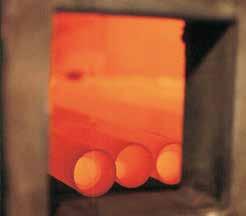
These results indicate greater resistance to impacts and crushing, easier machining and cutting. This also means the products are easier to install on job sites.
*Key mechanical characteristics required by standard EN 877 are checked by three tests, carried out on pipes when coming out of the heat treatment furnace to assess tensile strength, ring crush resistance and hardness. In addition, operators have opted to perform a further test which provides a good indication of the heat treatment quality: impact test.
Most solids expand when heated and are liable to elongate under temperature increases. For pipe systems made of materials that are subjected to high levels of thermal expansion, precautions must be taken at the design stage.
Cast iron, which expands very little, does not require specific bracketing or expansion collars. It makes the specifiers’ design work easier and avoids extra costs at the installation stage.
The thermal expansion coe cient for cast iron – 0.01 mm/m. °C – is very low and very similar to that of steel and concrete; the building and pipe systems will move and expand together.
For cast iron, the bracketing system is designed to only carry the weight of the pipe and its content, which makes the designers’ work easier. Plastic pipes, however, expand considerably with increasing temperature. Their bracketing system must be designed and adapted accordingly, as it can significantly a ect the pipework’s stability and performance over time.
To allow expansion without damaging the drainage network, plastic pipe systems require specific accessories –expansion collars or joints, brackets allowing axial movement, in general one of the two. If these precautions were not taken, expansion could be absorbed by the pipework and cause distortion.
Cast iron does not require these expensive accessories. It makes the design work easier and decreases the risk of mistakes at the installation stage.
These properties of cast iron pipe systems are also valuable for engineering structures such as bridges, where significant expansions have to be carefully addressed to secure the construction project.
Sanitary drainage systems, whether exposed or not, must remain watertight over time. Any defects can cause serious damage, leaks, dripping or slow permeation and generate costly repairs, and disruption. PAM Building cast iron mechanical assemblies are designed to easily achieve instant watertightness and are not dependent on process control (gluing or welding, etc.).
Cast iron is a dense and non-porous material. Cast iron pipe systems are watertight and impervious.
Straight and rigid cast iron components are assembled using metal couplings fitted with elastomer gaskets which ensure the system is completely watertight.
Assemblies benefit from a conventional approach. Put together with only simple tools, they allow installation tolerance with no risk of leaks.
This ease of installation ensures the specified performance is always obtained, even in adverse conditions, unlike with plastics when either gluing or welding can be affected by installation hazards (ambient conditions such as temperature or damp), or when personnel with special skills are required.
Failure of watertightness can occur on drainage systems in operation due to breaks,

The S and Plus ranges, assembled and anchored, have successfully passed a high-pressure jetting test: cleaning pressure of 120 bar from the pump, which means 100 bar at the nozzle outlet, without leaks or misalignment.
misalignments, crushes or cracks. Long-lasting watertightness depends on two main factors:
• No deterioration of pipes: Cast iron is highly resistant to ovality. Their specified mechanical properties and stability enable cast iron systems to withstand operating stresses extremely well.
• No deterioration of assemblies: Elastomers are carefully selected for the long-term stability of their physico-chemical characteristics to ensure the lasting watertightness of the rubber gaskets.
Some specific points on a pipe system may be subjected to thrust loads due to changes of direction and gradient, branches and plugs. To avoid any risk of disconnection or slippage of the pipe components, these loads must be addressed and the sections at risk must be anchored:
• A straight section of pipes may be held between two fixed points with ductile iron brackets, for example
• Alternatively, a selfanchoring coupling or an ordinary coupling anchored with a grip collar can be used


If you need help determining the choices for your project, please contact our technical support team on our website: www.pambuilding.com
Blockages can sometimes occur in drainage networks, therefore the pipework materials must be resistant so that maintenance is easy. The S and Plus systems can withstand all normal maintenance processes, including high-pressure jetting, without being damaged. They have undergone a high-pressure test according to Swiss standard SN 592 012.
The robustness and dimensional stability of cast iron components along with the careful selection of elastomer ensure pipe installations are high-performance and have a long service life.
Internal pressure in drainage networks rarely occurs and is always accidental. Thrust e orts in the overloaded sections have to be addressed to guarantee both watertightness and mechanical stability.
As the robust cast iron components can withstand any pressure hazard, the couplings will be subjected to the strain. The quality of the couplings and their careful selection according to their field of use will prevent misalignment or disconnection of the pipework.
Standard pressure mechanical couplings: Wastewater drainage systems – which di er from rainwater drainage systems as regards pressure –are connected to sanitary appliances installed on each storey which may serve as outlets in case of accidental overloading (due to blockages, for example). The pressures that occur cannot therefore exceed the pressure corresponding to the height of one storey, i.e. about 0.3 bar. The couplings we describe as” standard” are perfectly suitable for this common type of application.
High-pressure mechanical couplings: In some rare cases, a wastewater drainage system may pass through a number of stories without any outlet, and there could be a risk of overloading (blockage due to operation or saturation of the main sewer). The pressure resistance required to ensure these systems remain leaktight and stable in such cases depends on the height of the water column liable to occur, and in some cases calls for highpressure couplings able to withstand the resulting pressure (up to 10 bar).
As components that are integrated in buildings, wastewater and rainwater drainage systems must remain in a serviceable condition over the long term despite adverse operating conditions.
Ageing refers to any gradual, irreversible change in a material’s structure and/or composition, liable to a ect its behavior or serviceability.
When a material is selected, the stability of its properties ensures operational reliability over time.
The ageing of a material may be due to its own instability, environmental or chemical stresses, mechanical strains, or a combination of any of those causes.
It is an established fact that cast iron o ers long service, owing in particular to the stability of its mechanical properties over time.
Cast iron is not sensitive to thermal ageing
• Its mechanical strength remains stable.
• Its thermal expansion is very low compared to plastics.
• Cast iron pipe systems are not liable to creep at operating temperatures.
Cast iron does not deform under mechanical strain.
• Its ring sti ness (cold measurement) around 700 kN/m is not a ected by temperature and is 87 times that of PVC pipes. It is highly valued for buried pipework.
• Its longitudinal sti ness, which facilitates bracketing and protects the water stream in horizontal sections, remains intact. Its Young’s modulus of elasticity is from 80 to 120 GPa vs 2 to 5 GPa for PVC.
• Cast iron’s tensile strength is 8 times that of PVC: 200 MPa vs 25 (residual resistance, after 50 years according to the standards). This property is very important in case of network overloading.
The properties of cast iron ensure the stability of the systems and long-lasting operational safety.
The properties of materials are extremely important when they are stored in or exposed to adverse conditions (extended exposure to ultraviolet light or wide-ranging temperature variations, etc.). Cast iron undergoes no structural modification under climatic stresses.
Under the e ect of temperature, plastics can su er two kinds of deterioration, including at operating temperatures:

• Creeping is an irreversible elongation under the combined action of both temperature and a significant mechanical strain. Plastic pipe systems like PVC or HDPE are particularly sensitive; in the horizontal sections, they can bend between two support brackets under their own weight.
• Modification of the elastic limit: most plastic materials will soften when exposed to a temperature increase. With a decrease in temperature, however, they crystallise. PVC, for example, becomes rigid and may crack under mechanical strain – its operating temperature range is generally between -20°C and 80°C, but depending on its nature, the range can be much narrower.
Depending on their nature, climatic stresses (such as solar radiation, damp or heat) will cause photochemical ageing to plastic materials of varying severity.
They may merely alter their surface finish, or they may also deeply modify their mechanical properties and thus adversely a ect their serviceability.
The same can happen as a result of a slow chemical attack by solvents or even in an aqueous medium.
Building wastewater drainage systems - grey and black water- must be able to withstand the types of domestic e uents specified by standard EN 877. In recent years, however, changes have been observed in the types of these fluids:
• Hi gher concentration of household detergents,
• Use of more aggressive hygiene products,
• Rise in operating temperatures.
The constraints on sanitary drainage systems are constantly increasing.
To test chemical resistance of cast iron products, according to standard EN 877, the product samples are tested for 30 days at a temperature of 23 3°C with the following liquids (pH constantly monitored):
• A solution of sulfuric acid with a pH of 2
• A solution of sodium hydroxide with a pH of 12
• A solution of wastewater with a pH of 7
Resistance to hot water (24 h at a continuous 95°C) and thermal cycles (1,500 cycles of 5 min between 15°C and 93°C) are also tested according to standard EN 877.
To provide clearer guidance on the chemical resistance of the S range in domestic applications, PAM Building has carried out 20 further tests in addition to the requirements of standard EN 877 on commonly-used detergent products (floor cleaning products, laundry detergents, etc.) and special products (stain removers, drain cleaners, etc.). The additional tests also aimed to assess the S and Plus range limitations.
The tests were carried out on samples, under the temperature of use recommended by the manufacturers and, where relevant, up to 70°C since hot water is normally supplied in houses at around 50–60°C.
After stopping the test, the pipes and fittings were washed immediately to eliminate any stains, and the coatings were examined for blistering and rusting according to ISO 4628-2 and 3. (Accepted levels according to EN 877).
The duration of the test is considered equivalent to the extrapolation of real chemical stress undergone for 7 or 10 years (10 to 15 min of stress per day). This test method, however, simulates severe stress since the samples lie in direct contact with the solution, the temperature is maintained and the test includes no rinsing for its duration.
*according to the manufacturer
Recommended range for these applications: S range (see p.66)
According to the principle of continuity with no weak points, coatings for fittings and accessories must withstand the same stresses as pipes. There is an anti-corrosion coating process for these parts to ensure they can withstand major stresses, due to the fluids transported or the environment.
Fittings and accessories are coated with an epoxy resin deposited by cataphoresis which ensures a uniform deposit and excellent covering of edges. The optimised process by PAM Building is based on careful shotblasting and entails incorporating a chemical surface treatment during the coating cycle, between rinsing after shotblasting and the cataphoresis bath to enhance the coating’s covering power.
At the end of the cycle, the parts are oven dried to complete the reticulation of the epoxy film.
Substantial improvements in:
• The epoxy film’s adhesion to the cast iron
• The corrosion resistance of the coated cast iron

Aggressive e uents are characterized by their content (acids, bases, solvents, hydrocarbons, etc.), their combinations and their temperature.
Above- and below-ground wastewater drainage for aggressive discharge are characterised by:
• Hot water resistance: 24 h at a continuous 95°C and thermal cycles (1,500 cycles of 5 min between 15°C and 93°C)
• Plus range external coating corrosion resistance test to neutral salt spray according to standard NF-EN ISO 9227_2017: 2500 hours
• Chemical resistance: 1 < pH < 13
Recommended range for these applications: Plus range (see p.68)
The limitation between the S and Plus ranges is only determined by the type of fl uids and the operating temperature. However, the duration of daily exposure also directly
determines the appropriate range to select, hence why we called this chapter intensive or professional use. The combination of high pH products (base and alkaline products) and high temperatures systematically calls for the use of the Plus range.
With its anti-corrosion thick linings, the Plus range provides greater chemical resistance and is particularly well-suited to intensive uses.
• To transport effluents containing acids, bases or saline solutions at common operating temperatures, systematic use of the Plus range equipped with couplings with EPDM gaskets is recommended.
• For solvents, hot oil and where hydrocarbon traces may be present, the systematic use of the Plus range equipped with couplings with NBR gaskets is recommended.
Compulsory use of PLUS range + NBR gasket Solvents at common temperatures of use and hot oils
SOLVENTS (except Acetone)
Ethanol, methanol, glycol
Xylene
White Spirit
Gasoline, diesel, petroleum
Lubricants, petroleum derivates
High temperatures OILS
Compulsory use of PLUS range + EPDM gasket Acids and bases, saline solutions common temperatures of use
→ S Range is still possible
→ Plus range is compulsory
For uses not described or intensive industrial uses, please contact our technical support team:
tcbatiment.sgpam@saint-gobain.com
Tel: +33 (0)3 66 74 00 89
Below-ground wastewater drainage systems exposed to environmental stresses.
The buried section of a pipe may be laid in non-homogeneous ground or corrosive soil. When protected by galvanic e ect, the pipework can be installed without requiring systematic soil studies.
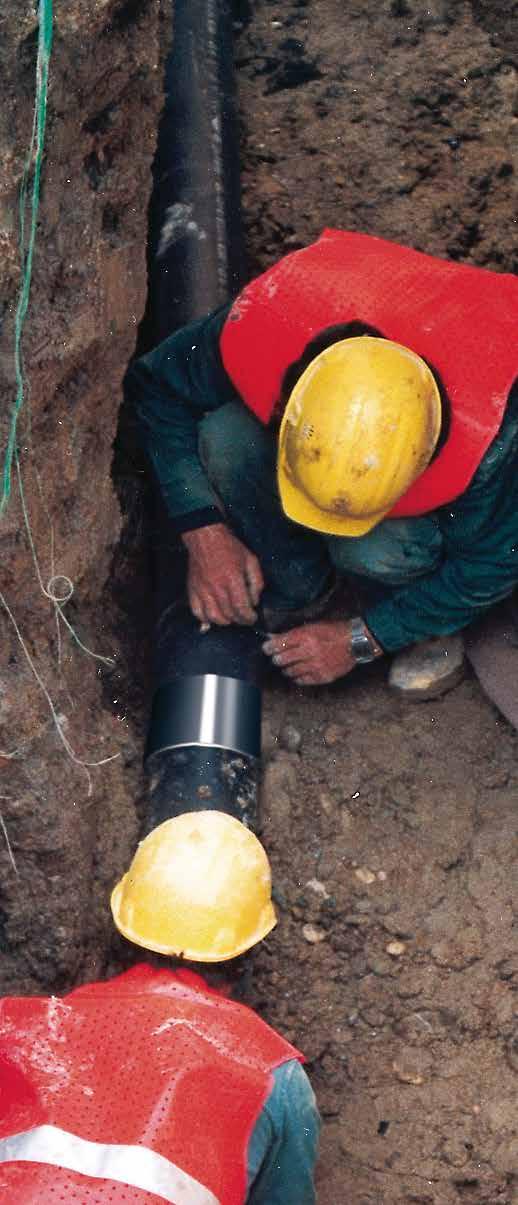
Recommended range for these applications: Plus range (see p.68)
Buried systems are subjected to ground loadings which can cause shearing strain on couplings. For these applications, it is therefore recommended to use wider couplings, and to use the “all stainless steel version” of the steel couplings to avoid corrosion due to the aggressiveness of the ground.
Depending on the climatic conditions, while in operation outdoor wastewater and rainwater systems can be subjected to ultraviolet radiation, saline mist, condensation, freezing-thawing cycles and pollution.
The drainage systems must be fit for purpose despite exposure to adverse conditions.
Zinc coating improves the pipes’ ability to withstand climatic stresses and extends their service life.
Recommended range for these applications: Zn range (see p.70)

The zinc metal coating is an active protection provided by the galvanic action of a zinc-iron cell.

This action is two-fold:
• Formation of a stable protective layer of insoluble zinc salts
• Self-repairing of any damage

Zinc metalisation is an excellent corrosion inhibitor and is extremely effective at extending the lifespan of products subject to backfills or climatic stresses.

The preservation of natural resources is a major societal challenge, especially for the construction sector, which is a major consumer of raw materials and energy. PAM Building evacuation systems are a responsible and sustainable choice, respectful of natural resources and people.
In order to contribute to the preservation of natural resources, PAM Building’s molten iron is produced by recycling cast iron and ferrous products. Unlike plastics, it can be completely and systematically recycled at the end of its life.
PAM Building’s drainage solutions can be recycled without any deterioration of their properties.
The product’s life cycle is also first-class in terms of environmentally-friendly logistics, longlasting functionality (up to 70 years without compromising the mechanical properties), low maintenance costs and commercially beneficial recycling.
100% recyclable indefinitely without losing any of its properties and made from 99% recycled content*
For the standard S range, recycled content is 99% with 11.5% pre-consumer** & 87.5% postconsumer*** according to ISO 14021: 1999.
Cast iron pipe systems are based on the principle of modular ranges of removable components. Their mechanical assemblies are reversible.
You can change your mind today or even tomorrow. When pipe systems are disassembled or modified, these components can be reused, which cuts down on waste dumping.
*Recycled content: proportion, by mass, of recycled material in a product or packaging. Only pre-consumer and postconsumer materials shall be considered recycled content.
** Pre-consumer material: material diverted from the waste stream during a manufacturing process. This excludes the reuse of materials such as rework, regrind, or scrap generated in a process and capable of being reclaimed within the same process that generated it.
*** Post-consumer material: material generated by households or commercial, industrial and institutional facilities in their role as end users of the product which can no longer be used for its intended purpose.
From waste recycled to fully recyclable products

99% 100% every year we recycle the equivalent of 18.000 cars on average.

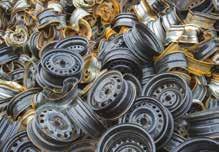
The recycling channel exists: collector network and recovery stream is existing and working!
We work with local supply for scrap (<125 km from the plant) to reduced economic and transport costs.

Following ISO 14021:1999 and LEED V4 criteria we can provide a recycled content declaration for our products.

Understanding the environmental performances of construction products is a growing expectation for professionals in the building chain.
In PAM Building, we strongly believe that Life Cycle Assessment is the most reliable tool available to assess the green credentials of construction products and enables companies to communicate credible, fact-based information about their products to consumers. It is also a powerful tool for enhancing the environmental features of our products.LCA is a methodology based on specific standards ISO 14040 and ISO 14044:
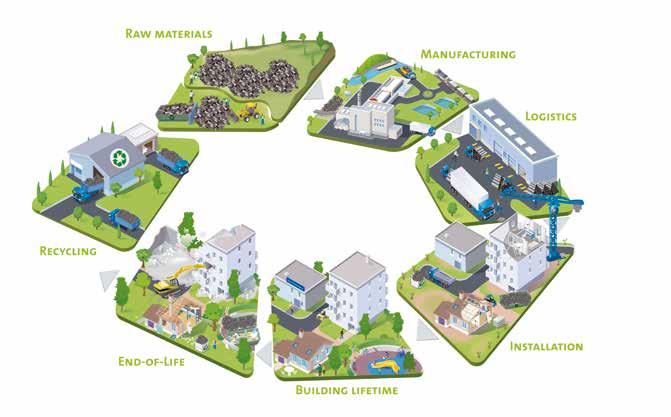

• Multi-criteria tool: consumption of natural resources, air, ground and water emissions, waste generation, warming potential, …
• Multi-step tool: “cradle to gate” or “cradle to grave”.
The results of a LCA are presented in the formof an Environmental Product Declaration, locally administrated by program operators and based on ISO 25930 and EN 15804 standards. When an EPD has been checked by an independent third party, it is said to be verified. This process ensures the quality and reliability of the results: that is why we are committed to have verified EPDs.
We currently have produced and verified EPDs for our S and Plus ranges, both available on the Environdec platform : www.environdec.com

This table enables a quick and synthetic overview of environmental footprint of the functional unit (1 m of SMU S cast iron pipe system for collection and drainage of waste water, sewage and rainwater in buildings), based on 70 years of lifetime.

The complete EPD is available on the international Environdec platform, registration number S-P-02013.
> Source: https://www.environdec.com/Detail/?Epd=18393



S RANGE (details on p.86)
DESCRIPTION:
Specialised range providing complete drainage solutions for transporting fluid waste and rainwater through buildings. High-quality cast iron pipes and fittings suitable for standard use applications. This range withstands di erent types of domestic e uents such as grey water, black water and rainwater.
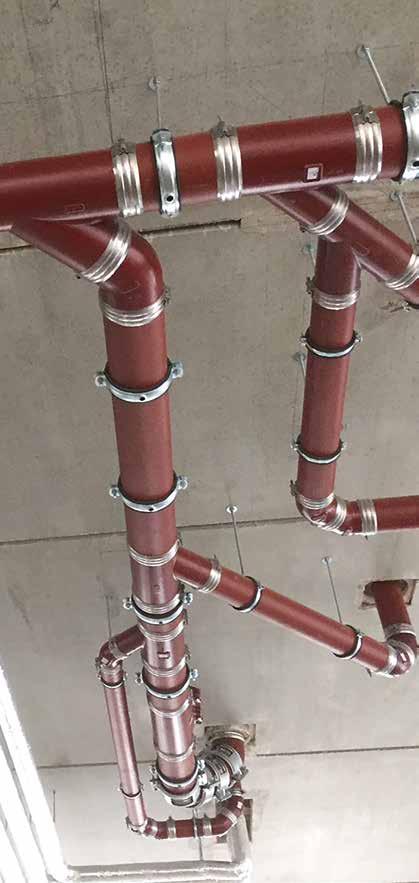
RECOMMENDED USE:
First choice for commercial, public and residential buildings, particularly medium- to high-rise buildings which require robust and safe solutions for basements and lower levels to vertical risers. Some common applications are:
• O ces
• Shopping centers
• Housing
• Airports
• Hotels
• Public builidings
• Stadiums
MAJOR BENEFITS:
• Compliant with standard EN 877
• Performance guaranteed with marks delivered by a third party (NF, RAL-GEG, Kitemark, BBA, Sintef, Gost, Q+)
• High level of fire safety with excellent A1 reaction to fire (non-combustible) and fire resistance up to 240 minutes depending on the configuration (generally requires no special fire protection saving time and costs)
• Best acoustic comfort with Lsc,A < 10 dB (A) according to EN 14366
• Ease of installation due to the mechanical couplings assembled with simple tools
• Adaptable to all configurations with available accessories connecting cast iron with other materials
• Limited maintenance operations thanks to the technical and mechanical properties of cast iron
CHEMICAL AND CORROSION RESISTANCE:
• Hot water resistance: 24 h at 95°C
• Thermal cycle resistance: 1,500 cycles between 15°C and 93°C
• Chemical resistance for 2 ≤ pH ≤ 12
DIMENSIONS:
• Diameter: 50 to 400 mm (up to 600 mm on request)
• Length: 3,000 mm
ENVIRONMENTAL DATA:
• Recycled content: 99%
• 100% Recyclable
COATINGS:
• Pipes:
External coating: Red-brown, acrylic primer paint, average dry film thickness 40 μm. Cast-iron made with the De Lavaud process
Internal coating: Two-component ochrecoloured epoxy coating, average dry film thickness of 130 μm.
• Fittings: Externally and internally coated in red epoxy to an average thickness of 70 μm.


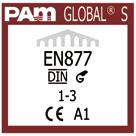

PRODUCT MARKING:
• Pipes:
Product name
Compliance with the RAL-GEG mark
Compliance with the DIN EN standard
• Fittings:
PLUS RANGE (details on p.108)
DESCRIPTION:
High-performance cast iron pipes and fittings designed to withstand intensive use. Smartly designed to drain wastewater in above- and below-ground applications when exposed to hot and/or aggressive discharge. When installed below ground in aggressive environments it is highly resistant to external stresses.
RECOMMENDED USE:
The Plus range is the first choice for hospitals, laboratories and collective kitchens.

MAJOR BENEFITS:
• Compliant with standard EN 877
• Performance guaranteed with marks delivered by a third party (NF, RAL-GEG, Kitemark, BBA, Sintef, Gost, Q+)
• Long-lasting operational safety thanks to the robustness and sti ness (around 700 kN.m) of cast iron and the use of flexible mechanical couplings
• High level of fire safety with excellent A2, s1-d0 reaction to fire and fire resistance up to 240 minutes depending on the configuration (generally requires no special fire protection, saving time and costs)
• Best acoustic comfort with Lsc,A < 10 dB (A) according to EN 14366
• Ease of installation due to mechanical couplings assembled with simple tools
CHEMICAL AND CORROSION RESISTANCE:
• Hot water resistance: 24 h at 95°C
• Thermal cycle resistance: 1500 cycles between 15°C and 93°C
• Chemical resistance for 2 ≤ pH ≤ 13, up to 80°C (check resistance for more than 30 di erent e uents in the tables on p.56 and 57)
• External coating corrosion resistance test to neutral salt spray according to standard NF-EN ISO 9227_2017: 2500 hours
DIMENSIONS:
• Diameter: 50 to 400 mm (up to 600 mm on request)
• Length: 3000 mm
• Recycled content: 99%
• 100% Recyclable
COATINGS:
• Pipes:
External coating: Grey, acrylic primer paint, average dry film thickness of 40 μm.
Anti-corrosive zinc coating of 130 g/m2
Cast-iron made with the De Lavaud process
Internal coating: Two-component ochre-coloured epoxy coating applied in two layers, average dry film thickness of 250 μm.
• Fittings:
Externally and internally coated with a grey powder epoxy to an average thickness of 300 μm.




PRODUCT MARKING:
• Pipes:
Product name
Compliance with the RAL-GEG mark
Standard
• Fittings:
ZN RANGE (details on p.120)
DESCRIPTION:
High-performance cast iron pipes designed to withstand external stresses due to climate exposures (ultraviolet radiation, saline mist, condensation, freezing-thawing cycles and pollution)
RECOMMENDED USE:
The Zn range cast iron drainage system is recommended for applications in coastal areas, directly or indirectly exposed to climatic stresses and/or polluted atmospheres, polluted or confined atmospheres such as cellars, crawl spaces or those which may be exposed to external aggressions during manufacturing processes and condensation.
MAJOR BENEFITS:
• Compliant with standard EN 877
• Performance guaranteed with marks delivered by a third party (NF, Watermark)
• Resistance to climatic stresses thanks to the zinc coating, withstanding extended exposure to ultraviolet light or wide temperature variations

• High level of fire safety with excellent A2, s1-d0 reaction to fire and fire resistance up to 240 minutes depending on the configuration (generally requires no special fire protection, saving time and costs)
• Best acoustic comfort with Lsc,A < 10 dB (A) according to EN 14366
• Ease of installation due to mechanical couplings assembled with simple tools
CHEMICAL AND CORROSION RESISTANCE:
• Hot water resistance: 24 h at 95°C
• Thermal cycle resistance: 1500 cycles between 15°C and 93°C
• Chemical resistance for 2 ≤ pH ≤ 12
• External coating corrosion resistance test to neutral salt spray according to standard NF-EN ISO 9227_2017: 3500 hours
DIMENSIONS:
• Diameter: 50 to 400 mm (up to 600 mm on request)
• Length: 3000 mm
ENVIRONMENTAL DATA:
• Recycled content: 99%
• 100% Recyclable COATINGS:
• Pipes:
External coating: red-brown, acrylic primer paint, average dry film thickness of 40 μm.
Anti-corrosive layer: flame-applied zinc metal coating of 260 g/m2 on average
Cast-iron made with the De Lavaud process
Internal coating: two-component ochre-coloured epoxy coating, average dry film thickness of 130 μm.

• Fittings: Please contact us for details of the fittings to be used with the Zn range pipes

PRODUCT MARKING:
• Pipes:
RESIDENTIAL (TYPE R) (details on p.122)
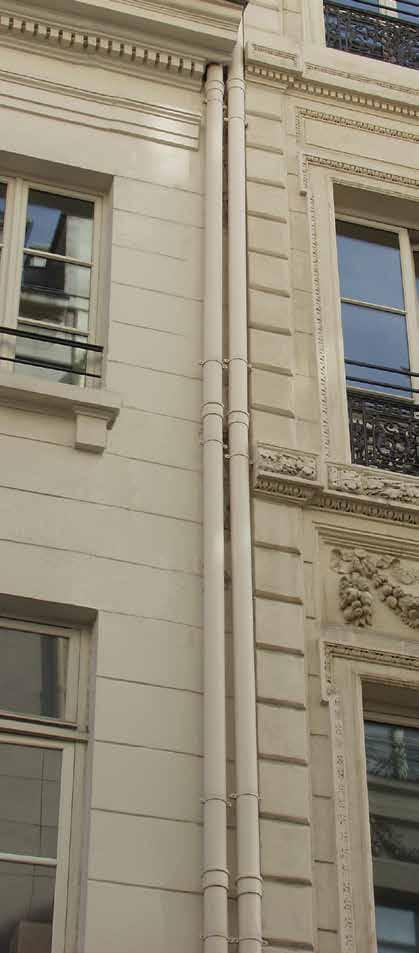
MAJOR BENEFITS:
• Compliant with standard EN 12056-3
• Additional value to buildings due to the round or fluted aesthetic appearance of the Residential drainage solution
• Low maintenance due to the best in class resistance to shocks and crushing
• Long lifetime with high resistance to climatic stresses due to the zinc coating and the low thermal expansion coe cient of cast iron


• High level of fire safety with excellent A1 reaction to fire (non-combustible)
• Ease of installation due to the push-fit assembly system
MECHANICAL RESISTANCE:
• Shock resistance:
The test consists of dropping a mass of 2.75 kg on a descent at increasing heights until it breaks or cracks.
The average height of the fall for Residential (Type R) is 2 to 5 times higher than for other products. Up to an average drop height of 2 m, the Residential (Type R) deforms while the other products have cracked.
• Crushing resistance:
DIMENSIONS:
• Diameter: 75 – 100 – 125 mm
• Length: 1000 and 2000 mm
ENVIRONMENTAL DATA:
• Recycled content: 99%
• 100% Recyclable
COATINGS:
• Pipes:
External coating: light beige colour (RAL 7032), water-based coating of 40 μm.


Anti-corrosive layer: flame-applied zinc metal coating of 130 g/m2 in average

Cast-iron made with the De Lavaud process
Internal coating: water-based coating of 40 μm.
• Fittings: Cataphoresis 70 μm + water-based coating 60 μm.

EPAMS® (details on p.126)
The EPAMS® system is a combination of cast iron pipes, fittings and accessories, jointed with PAM Rapid couplings or couplings able to withstand a negative pressure of -700 mbar.

EPAMS outlets are equipped with an anti-vortex mechanism that prevents air from entering the pipes at rainwater inlets. The absence of air then causes an acceleration of the flow by creating a negative pressure.
• System under French Technical Approval EPAMS® 5.2/14-2386_V2
• Suitable for all ambitious architecture and all roof types*
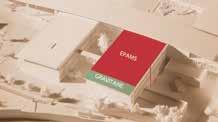
• Cost-e ciency via savings on purchases and installation costs: fewer downpipes than gravity systems
• Suitable for all areas and rainfall: high volumes of water drained up to 75 l/s per outlet


• Low and easy maintenance with a durable system: no claim since its launch (1994)
• Technical study and network sizing provided by PAM Building through the dedicated EPAMS® software
• 2D and 3D design available
• Job site inspection
INSTALLATION:
• See p.178
*For more details please consult French Technical Approval EPAMS 5.2/14-2386_V2 or contact us: tcbatiment.sgpam@saint-gobain.com
DIMENSIONS:
• Diameters : 50 – 75 – 100 – 125
PRODUCT RANGE:
• EPAMS® outlet to be welded
Application field: This roof outlet is especially designed to be welded (or brazed) in gutters or metal roof valleys.




• EPAMS® outlet with flange
Application field: This roof outlet can be used for roofs containing extra-thick metal gutters or valleys as well as for roofs waterproofed by synthetic membranes.
• EPAMS® outlet with steel plate




Application field: This roof outlet is used on all the roofs mentioned within the scope of the French Technical Assessment 5+14/14-2386, except those with waterproofing by a synthetic membrane.
• EPAMS® outlet for flexible PVC membrane
Application field: This roof outlet is used on non-accessible roofs and/or with equipment zones, and waterproofed by synthetic PVC-P membranes depending on the manufacturer’s technical assessment. Waterproofing is provided by a weld between the various PVC elements to seal them in a traditional way. The membrane may be visible or may be given heavy mineral protection. For the latter case, it is possible to use gravel > 15 mm, but the roof outlet must be fitted with an elevating kit for the anti-vortex mechanism.
ITINERO® (details on p.128)
DESCRIPTION:
The Itinero® range is a solution that meets the high drainage technical demands of infrastructure projects.
Itinero® is a dedicated range which factors in the specificities of a project and guarantees excellent performance to accommodate di erent stress levels (weather constraints or exposures).
RECOMMENDED USE:
It is recommended for collecting and draining surface water from bridges, tunnels and viaducts, for new builds or renovation projects.
MAJOR BENEFITS:
• Compliant with standard EN 877
• Performance guaranteed with marks delivered by a third party (NF)
• Long lifetime with high resistance to climatic stresses due to the zinc coating and low thermal expansion coe cient of cast iron
• Low maintenance due to the best in class resistance to shocks and crushing
• High level of fire safety with excellent A2,s1-d0 reaction to fire (non-combustible)
• Suitable for many bridge and tunnel designs and adapted to renovation projects

• Easy to install due to mechanical couplings assembled with simple tools
TECHNICAL SUPPORT :
• We provide design recommendations, discharge system set-up and a bill of quantities for your project. Contact us at: tcbatiment.sgpam@saint-gobain.com
CHEMICAL AND CORROSION RESISTANCE:
• Hot water resistance: 24 h at 95°C
• Thermal cycle resistance: 1,500 cycles between 15°C and 93°C
• Chemical resistance for 2 ≤ pH ≤ 12
• External coating corrosion resistance test to neutral salt spray according to standard NF-EN ISO 9227_2017: 4500 hours
DIMENSIONS:
• Diameter: 100 to 600 mm
• Length: 3000 mm
ENVIRONMENTAL DATA:
• Recycled content: 99%
• 100% Recyclable
COATINGS:
• Pipes:
External coating: Grey (approximate RAL 7030), epoxy coating, average dry film thickness of 80 μm
Anti-corrosive zinc coating of 260 g/m (about 40 μm)
Cast-iron made with the De Lavaud process
Internal coating: epoxy coating, average dry film thickness of 130 μm.
• Fittings: Externally and internally coated with a mat grey powder epoxy (approximate RAL 7030), to an average thickness of 300 μm
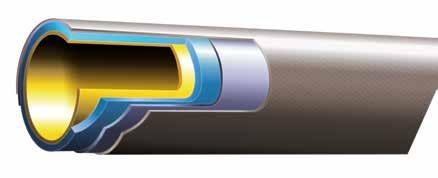


PRODUCT MARKING:
• Pipes:
Pipe
Standard conformity
Compliance with the DIN EN standard
• Fittings:

An earth-to-air heat exchanger (EAHX) is a surface geothermal solution for buildings, involving a buried pipe system which circulates fresh air.
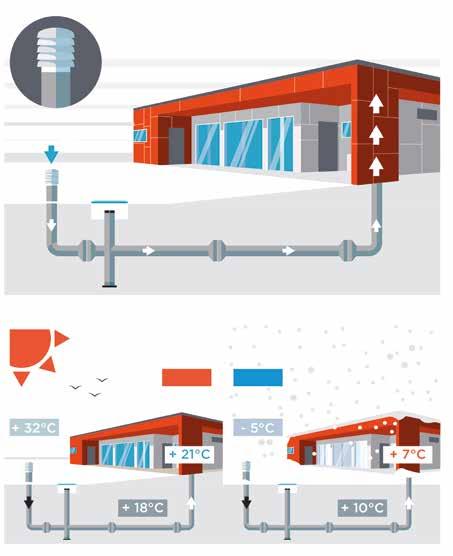
It aims to warm up fresh air in buildings in winter and cool it down in summer. Based on thermal air-to-ground exchanges, it is a passive solution. Where installed, the earth-to-air heat exchanger plays an active role in the building’s thermal comfort.
ELIXAIR® by PAM is a comprehensive o er, designed to build earth-to-air heat exchangers combining safety and e ciency with ductile iron products.
A ventilation system di use the temperate air inside the building
In summer, the Elixair® system cools the air
In winter the Elixair® system heats the air
• Public buildings
• Commercial and industrial buildings
• Farm buildings
• System under French Technical Approval 14.5/14-2056_V1
CSTB
• Energy savings thanks to the complete system and the high thermalconductivity of ductile iron
• Resistance to ground loading and tra c: ductile iron pipe systems can be buried deep without damage, also under areas which are driven over or car parks

• Withstands rustic laying conditions allowing backfill with the extracted materials
• Excellent air tightness due to Express or Standard couplings working under compression
• Durability: as for all buried systems, strength and longlasting properties are key factors to avoiding premature replacements
• In winter: in-out average temperature di erence = 7 to 12°C
• In summer: in-out average temperature di erence = 7 to 16°C
Send us your project and we will be able to help you with the supply of:
• Your earth-to-air heat exchanger
• The bill of quantities
• The heat energy saved in winter
• The cooling energy saved in summer
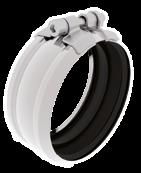
A coupling is made of several components: casing, screws, barrel and gasket as described in the drawing.
We follow a global material designation* for steel components of the coupling described in the following table.
*Please refer to datasheet for specific information as some material may differ depending on the coupling design.
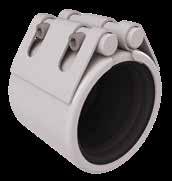
The choice of the elastomeric gasket is related to the nature of the effluent.
EPDM: EPDM rubber is suitable for most types of effluents.
NBR: Nitrile Butadiene Rubber is recommended for wastewater and runoff water liable to contain hot oil, solvents or hydrocarbons. They are recommended for infrastructure applications.
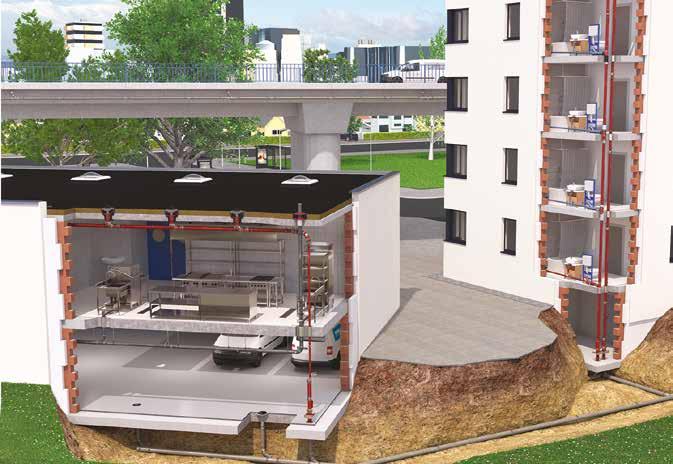
(details on p.132)
We provide a large range of couplings to match all building specifications. Our products are available in di erent versions to withstand all types of e uents, pressures and external stresses.
The single-bolt PAM Rapid coupling allows fast and reliable installation. It ensures optimized watertightness, pressure and corrosion resistance.
MAJOR BENEFITS:
• Compliant with standard EN 877
• Ease of installation
• Suitable for projects with effluents containing solvents, hydrocarbons (i.e. car parks), due to the availability of the NBR version (nitrile gasket)
MATERIAL:
• Main material: W2 or W5 (AISI 316L)
• Gasket: EPDM or NBR
PRESSURE RESISTANCE:
• Exceeds the EN 877 requirements – DN 50 to 125: 10 bar / DN 150 to 200: 5 bar / DN 250 to 300: 3 bar
“R” for Repair: this coupling is particularly suited to repairs and retrofits. It is installed in two separate parts.


MAJOR BENEFITS:
• Compliant with standard EN 877
• Full opening strap particularly suited to renovation projects
MATERIAL:
• Main material: W5 (AISI 316L)
• Gasket: EPDM
PRESSURE RESISTANCE:
• Exceeds the EN 877 requirements – DN 50 to 125: 10 bar / DN 150 to 200: 5 bar
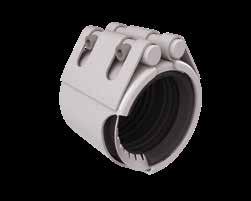

PAM HP FLEX couplings withstand up to 10 bar of hydrostatic pressure for most diameters. These couplings are used for straight runs where the pressures can occur.
MAJOR BENEFITS:
• Compliant with standard EN 877
• The solution for large-diameter networks (>300 mm)
MATERIAL:
• Main material: W4 (AISI 304) or W5 (AISI 316L)
• Gasket: EPDM or NBR
PRESSURE RESISTANCE:
• Exceeds the EN 877 requirements –DN 100 to 400: 10 bar / DN 500 and DN 600: 6 bar
In sections where end thrust e orts have to be addressed, the autogrip couplings are alternative solutions for securing junctions whilst addressing pressure. The PAM HP GRIP couplings are self-anchored couplings with built-in claw rings.
MAJOR BENEFITS:
• Compliant with standard EN 877
• The 2-in-1 solution: coupling and grip collar with only one product
• Particularly suited to EPAMS® installation
MATERIAL:
• Main material: W4 (AISI 304) or W5 (AISI 316L)
• Gasket: EPDM or NBR
PRESSURE RESISTANCE:
• Exceeds the EN 877 requirements –DN 100 to 400: 10 bar / DN 500 and DN 600: 6 bar

WASTEWATER
› Domestic use: P AM-GLOBAL® S
› Intensive use: PAM-GLOBAL® Plus, SMU Zn

RAINWATER
› Gravity systems: Residential (Type R)
› Siphonic systems: EPAMS®
INFRASTRUCTURE
› Itinero®
* For dimensions over DN 400 please contact us.
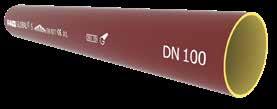

* For dimensions over DN 400 please contact us.






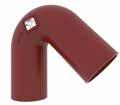






BENDS I 88° Vented bends

* For dimensions over DN 400 please contact us.
“All dimensions are in mm and nominal weights are in kg”












Corner branchesShort corner branches




Single long arm branches

* For dimensions over DN 400 please contact us.

See p.151 for information on resistance to accidental pressure. Expansion plugs with bleeding valve are available on request for DN 125/DN 150 and DN 200 (for watertightness tests).



(*) Bottom cleaning access: EP by expansion plug / TS by tight sheet Designed for rainwater networks. The arrows stamped on the cast iron body show the flow direction.


Traps DN ≥ 250: Installation with 88° bends
Anti-syphon traps with bottom access door DN 50
Anti-syphon traps with bottom access door DN 100-150
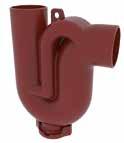


Suitable for all wastewater drainage systems, the Anti-Syphon Trap is particularly well-suited to systems without secondary ventilation. It ensures the retention of a water seal within the body of the trap to prevent odors traveling backwards through the system and fouling the atmosphere around sinks, washbasins, baths, rainwater outlets, etc. The Anti-Syphon Trap works by preventing the siphoning effect of a heavy discharge through the system. It does this through the internal partition within the trap allowing the air to bypass the water, thus breaking the vacuum created by the discharge water.


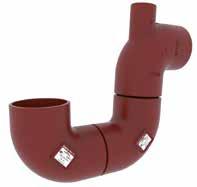





The multi-waste manifold simplifies waste plumbing by grouping all associated pipework from various sources such as sinks, basins, bidets, urinals and showers to one internal point above the finished floor level.
See p.174 for installation details.

Branches for single downpipe with 2 to 3 inlets - combined networks
Conditions of use: Fittings intended to absorb the relative movement between two components of pipework; each one of its ends is fixed to 2 different structure elements.
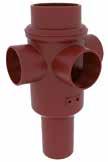
L is the dimension of the compensator in neutral position. The maximum authorised movements along the three axes are noted:
X axial movement
Y vertical radial movement
Z horizontal radial movement
Every reference is composed of:
• one movement absorber
• two bi-directional stack support pipes
Acceptable pressure for DN 75 to 200:
• negative pressures up to - 0.9 bar
• positive pressures up to 3 bar (accidental and internal hydrostatic pressure)


* For dimensions over DN 400 please contact us.


* For dimensions over DN 400 please contact us.





*For dimensions over DN 400 please contactus.

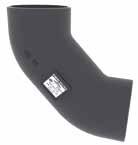

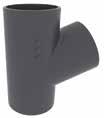
Single branches



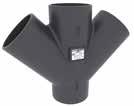
Corner branches - Short corner branches


INTENSIVE USE - PAM-GLOBAL® Plus
Single long arm branches

*For dimensions over DN 400 please contact us.



W
See p.151 for information on resistance to accidental pressure. Expansion plugs with bleeding valve are available on request for DN 125/DN 150 and DN 200 (for watertightness test).

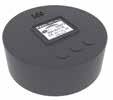
(*) with bottom cleaning access: EP by expansion plug / TS by tight sheet

Designed for rainwater networks. The arrows stamped on the cast iron body show the fl ow direction.
Designed for rainwater networks when subjected to aggressive environments.

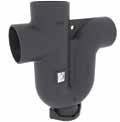
* For dimensions over DN 300 please contact us.

For details of the fittings to be used with SMU Zn pipes, please contact us.
“All dimensions are in mm and nominal weights are in kg”
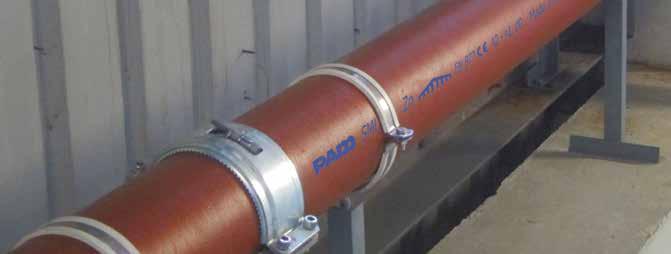








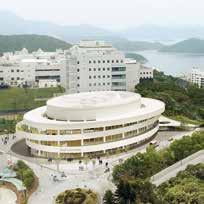
GRAVITY SYSTEMS - Residential (Type R)
All our Residential (Type R) downpipes and fittings are delivered with their couplings (see p.124 )
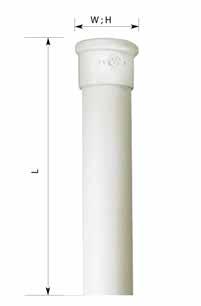

ROUND DOWNPIPES I Straight
ROUND DOWNPIPES I Bended


BENDS I Round downpipe bends

*Availability: Contact us
OFFSETS I Round offsets
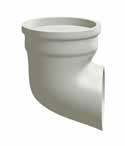








• Stainless steel body, including M10 bolts
• Aluminum grating
*This outlet is the basis for the next three outlets, on which various elements are grafted depending on the application field. See p.179 for main dimensions.
• Stainless steel body, including M10 bolts
• Aluminum grating
• Aluminum flange
• Stainless steel body, including M10 bolts



• Aluminum grating
• Stainless steel plate - 500 x 500 mm
• Stainless steel body, including M10 bolts
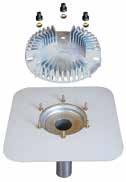
• Aluminum grating

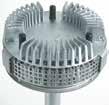
• Laminate-steel PVC plate - 500 x 500 mm

• Anti-vortex device fitted to Elevating Kit
• For roofs with waterproofing protection by fine gravel or by flags on isolating layer by fine gravel
ITINERO® - FITTINGS

BENDS I Short radius bends








Standard version W2 technical specifications: Strap, clamps:

1.4510 /11 (AISI 430Ti / 439)
All stainless steel version W5 technical specifications:
Strap, clamps:
1.4404 / 1.4571 (AISI 316 L/316Ti)
Screw and nut: austenitic stainless steel A4-70 or AISI 316
The PAM Rapid is designed for full tightening with “zero gap”, there is no need to check the torque. For DN 250 and 300, apply the following torque: 25 N.m.
For wastewater liable to contain hot oil, solvents or hydrocarbons, it is recommended to use couplings equipped with specific NBR gaskets.
All stainless steel
Strap: austenitic stainless steel1.4404/1.4571

(AISI 316L/316Ti)
Barrels: austenitic stainless steel
-1.4404/1.4571 (AISI 316/316L/316Ti)
Screw: stainless steel A4-70, with anti-seizing coating.
(thrust collar: AISI 316/316L)
Sealing gasket: EPDM

Type W4
Casing: 1.4301 / AISI 304
Screws: 1.4404 / AISI 316L
Barrels: 1.4401/ AISI 316
Strengthening plate: 1.4301 / AISI 304
Sealing gasket: EPDM or NBR
Type W5
Casing: 1.4404 / AISI 316L
Screws: 1.4404 / AISI 316L
Barrels: 1.4401/ AISI 316
Strengthening plate: 1.4404 / AISI 316L
Sealing gasket: EPDM or
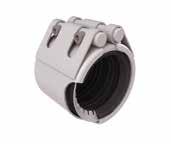
Totally versatile, the PAM grip collar is compatible with all the PAM designed couplings or those of equivalent shape.

“All dimensions are in mm and nominal weights are in kg”

Stepping rings
For connection to other materials refer to the table on p.171.
cast iron connector offer, connect pipe and fittings or material type. The S and PLUS ranges for valve water and rainwater. a PAM Rapid coupling Adapting Collars (AC) and circumference.
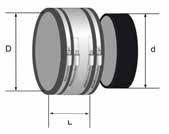


MATERIAL
• 100% elastomer EPDM
APPROVALS
ENVIRONMENTAL DATA
* External diameters of other materials
• Recycling Information: Partially recyclable
* minimum / maximum external diameter of the pipes to be connected
tcbatiment.sgpam@saint-gobain.com • www.pambuilding.com
tcbatiment.sgpam@saint-gobain.com www.pam-drainage-solutions.com
* minimum / maximum external diameter of the pipes to be connected


* minimum / maximum external diameter of the pipes to be connected
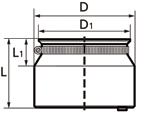
Transitional connectors
DN 50-125 are designed for connecting the cast iron S and Plus ranges to other materials, whether steel or plastic. The connections with these flexible connectors are easy and safe: one pre-cut lid and a lip seal inside (see figure). EPDM and hose clamp made of chrome steel no. 1.4016.
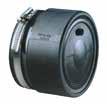



For connecting up to three 32-56 mm pipes made out of other materials to a cast iron pipe system DN 100. EPDM and hose clamp made of chrome steel no. 1.4016.

The Multiquick connector DN 100x70 allows connections between other materials with an outside diameter from 72 to 110 mm, to our cast iron range DN 100 with a maximum outside diameter of 115 mm. There are several pre-cut options. EPDM and hose clamp made of chrome steel no. 1.4016.

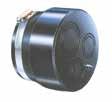
Quick hooking thanks to the opening
In galvanised steel. Distance between pipe and wall: 1 cm.
Fixing settings
Ease of fixation thanks to a 4 cm opening in the upper part of the hook

Reduced bearing surface Recesses to address wall roughness
Automatic set up Level marking on the hook that represents the waterline AS13 aluminium / not corrodible
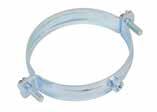

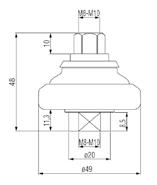






CANTILEVER ARM 41/21/2 LG 200 - DN 50 and 75



* F: Maximum load for 2 arms, when applied at mid-length of the arm (L/2), in daN
CANTILEVER ARM 41/ 41/ 2 LG 300 - DN 100 to 150
* F: Maximum load for 2 arms, when applied at mid-length of the arm (L/2), in daN
CANTILEVER ARM 41/ 82/ 2 LG 450 - DN 200 to 300
* F: Maximum load for 2 arms, when applied at mid-length of the arm (L/2), in daN

* F: Maximum load for 2 arms with reinforcement, when applied at mid-length of the arm (L/2), in daN

Galvanised zinc in combination with stack support bracket




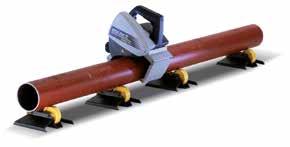
After any cutting operation, the pipe ends must be protected by applying EXTREM 1. EXTREM 1 is a ready-to-use quick drying touch-up paint that air dries in 15 minutes. It is easily applied with a brush (included in the paint bucket)

TOUCH-UP SPRAY PAINT ( 400 ml )








Standard requirements according to EN 12056
Gravity wastewater drainage systems and ventilation systems generally operate without pressure. Although this does not exclude the possibility of pressure arising in the systems under specific operating conditions.
EN 12056-1, Section 5.4.2 Water and Gas Tightness, states that drainage installations must be sufficiently water and gas tight to withstand operating pressure. Furthermore, EN 12056-5, Section 6.3 states, with respect to securing pipe systems: Non-anchored pipes must be secured and/or supported in such a manner that they cannot be disconnected during use. The arising reaction forces must be addressed. For the specific application of rainwater, EN 12056-3, Section 7.6.4. stipulates: Internal rainwater pipes shall be able to withstand the head of water likely to occur in the event of a blockage. The same precautions should be taken as on pipework liable to undergo accidental overloading: securing of bottom bends and joints with adequate grip collars or HP couplings.
Fluid pressure is the force the fluid exerts per surface unit, perpendicular to this surface. Pressure change applied to the surface of an enclosed fluid is transmitted evenly and undiminished in all directions. Robust cast iron components can address any pressure hazard, so the couplings will be subjected to the strain. Couplings designed by PAM building are tested under hydrostatic pressure; only grip collars and autogrip collars are tested under end thrust forces.
In addition to the above standards, in a drainage network, pressure resistance requirements are dependent on:
• The height of the water column between the considered point of the network and the first outlet located upstream; generally speaking, we di erentiate waste and toilet networks from rainwater.
• The accidental risk of loading. The most frequent cases are due to occasional obstruction of downstream pipeline or saturation of the public network.
Generally, the pressures that occur in wastewater drainage systems cannot exceed the pressure corresponding to the height of one storey, i.e. about 0.3 bar, as sanitary appliances on each floor serve as outlets in case of accidental overloading. The couplings we describe as “standard” (PAM Rapid and PAM R) meet these requirements.
In very rare cases, where domestic wastewater downpipes cross several levels of a building without any outlet, and where there would be a risk of accidental loading, the installation must comply with the recommendations applicable to rainwater networks.
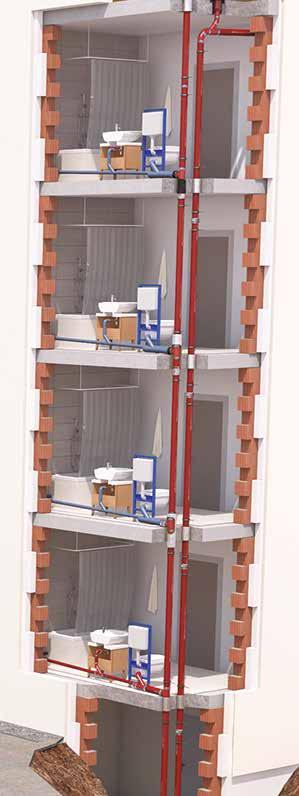
Same as wastewater networks.
In some rare cases there could be a risk of accidental overloading. The pressure resistance required to ensure these systems remain leak tight and stable depends on the height of the water column liable to occur, and could call for high-pressure couplings able to withstand the resulting pressure (up to 10 bar).
Coupling solutions will be differentiated for building height between 0 to 30 m, 30 to 50 m, 50 to 100 m corresponding to different levels of pressure resistance requirements.

» Straight runs of the pipework
Straight runs between two fixed points and rigid bracketing do not experience exceptional forces. In case of accidental overloading, the couplings will only have to address hydrostatic pressure. Standard pressure couplings withstand up to 10 bar for DN50-DN125, up to 5 bar for DN150-DN200, up to 3 bar for DN250-DN300. High pressure couplings withstand up to 10 bar for DN100-DN400 and up to 6 bar for DN500 and DN600.
» Stack support
On vertical straight runs, stack support pipes should be installed to address the stacks’ weight. At the bottom of the stack, the first stack support pipe addresses both the pipes’ weight and the end thrust effort. For the last case, it is recommended that the support and fixings be adapted accordingly. We recommend positioning the first stack support pipe at the base of the first floor, and then every subsequent fifth floor, in the case of a standard average 2.5 m between floors, or more generally every 15 m

» Changes of direction and specific elements (plugs, branches, bends)
End thrust forces can be exerted with changes of direction, gradient and specific components like branches and plugs. These forces have to be addressed to avoid any risk of the pipe system disconnecting or slipping using specific couplings.
It is considered that end-thrust effect must be addressed when drainage pipework may be exposed to an internal pressure higher than 0.5 bar.
In such conditions, the installation must be able to stay in place to perform its functions of water tightness, and mechanical stability, preventing any dislocation at the couplings. Grip collars and gripped HP couplings are part of the solutions to secure the network.
End thrust effect:
The result of the pressure forces exerted by a stationary fluid on the singular points of a pipe (or changes in direction), thus:
• Straight runs (pipes): the forces cancel each other out.
• Singular points (e.g. fittings): the resultant forces tend to dislocate the network.
The forces significantly increase with large pipe diameter as illustrated in the following table.
Thrust effect under 5 m water column (daN), corresponding to a 0.5 bar pressure.
It is considered that end-thrust effect must be addressed for:
1. Pipes laid under the groundwater table
2. Rainwater pipes or wastewater pipes running through several stories without outlets
3. HP>5 m as indicated on p.153
4. EPAMS – gripped collars or gripped couplings are mandatory until positive pressure is reached.
In these areas, the forces have to be addressed to avoid any risk of the pipe system disconnecting or slipping:
• Isolating the section suspected of having thrust forces between two fixed points, like stack support pipes.
• Adapting the joints (selection of couplings solutions) between these fixed points.
To address the thrust forces, other solutions can be used, like anchoring in concrete, or using dedicated bracketing systems.
Couplings + Grip collars: performance





Note: under end thrust forces, where a coupling is secured with a grip collar, the maximum performance of both is limited by the weakest performance of the two products.
Focus on the PAM grip collars installation
Position the two half parts of the PAM grip collar uniformly so it encircles the pipe in parallel. The grip collars must be positioned so that the apertures fit over the coupling's fixing bolts and the teeth are directly located onto the pipe.
The assembly is completed when the external edges of the plates are in contact on both sides.

Before deciding which type of coupling to use it is important to answer the following questions:
• Wastewater or rainwater network?
Generally, the pressures that occur in wastewater drainage systems cannot exceed the pressure corresponding to the height of one storey, i.e. about 0.3 bar, as sanitary appliances on each floor serve as outlets in case of accidental overloading.
• Diameter of the pipes?
Thrust forces will be significantly larger for large diameter pipes and will have to be addressed with grip collars and HP couplings. Pressure resistance of couplings are specific for a given diameter. For DN 400 and larger only HP couplings are available.
• Height of the stack?
The higher the stack is, the higher the potential pressure build-up.
• Location of the coupling along the system?
Recommendations will change between 0 m < H ≤ 30 m, 30 m < H ≤ 50 m, and 50 m < H ≤ 100 m as the height of the water column will correspond to different pressure levels.


• Straight run or change of direction?
Thrust effort will have to be addressed at change of directions
Different coupling recommendations should be followed depending on the number of floors and the HP height. In case of several storeys without outlet, the installation must comply with the recommendations applicable to rainwater networks.






Straight Run H1 PAM Rapid S
Change of direction H1 PAM Rapid S + grip collars
Straight Run H2 PAM Rapid S

Straight Run H3 PAM Rapid S
Change of direction H3 PAM Rapid S + grip collars


Change
A drainage pipe is normally at neutral air pressure compared to the surrounding atmosphere. When a column of wastewater flows through a pipe, it compresses air in the pipe, creating a positive pressure that must be released or it will push back on the waste stream and downstream traps’ water seals. As the column of water passes, air must flow in behind the waste stream or negative pressure (suction) results. The extent of these pressure fluctuations is determined by the waste discharge fluid volume.
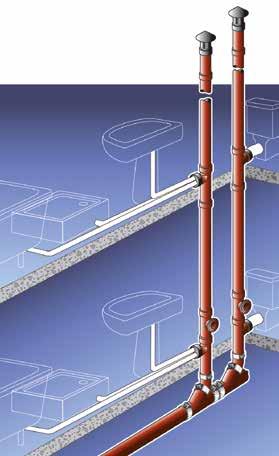
The purpose of a ventilation stack is to control presure in the pipework to prevent foul air from the wastewater system entering the building. Below are some of the main configuration principles, but combinations and variations are often required (see standard EN 12056-2). The purpose of a ventilation stack is also to avoid accumulation of dangerous gases.
Black water and grey water can be drained either in separate or in a single discharge stack. The rules for duct sizing are different depending on the option selected.
Control of pressure is achieved by air
flow in the discharge stacks. The soil stacks extend in main roof vents to above and out of the roof. Alternatively, air admittance valves may be used. They are pressure-activated, one-way mechanical vents, used in a plumbing system to eliminate the need for conventional pipe venting and roof penetrations.
In buildings of three or more storeys, if the air pressure within the stack suddenly becomes higher than ambient, this positive transient could cause wastewater to be pushed into the fixture, breaking the trap seal.

Vent stacks are put in parallel to waste stacks to allow proper venting and prevent such disorders. Air admittance valves may also be used in this configuration.
Under many building codes, a vent stack, a pipe leading to the main roof vent, is required to the draining fixtures (sink, toilet, shower stall, etc.).
To allow only one vent stack and therefore one roof penetration, as permitted by local building codes, sub-vents may be tied together and exit a common vent stack.
The single stack branch is a patented device made to allow wastewater drainage without secondary vent pipes. Provided the maximum number of connected sanitary appliances is respected, the single stack branch properly drains wastewater in a single stack, without vent pipes, whilst limiting the risks of self-siphonage. This device complies with standard EN 12056. Please consult local requirements for compliance with other regulations. The branch for a single downpipe allows wastewater drainage in a combined network without secondary ventilation according to EN 12056.

Field of use:
• Multi-connection of sanitary appliances for adjacent apartments, or sanitary blocks
• Compactness when space is limited
• No secondary vent pipes are required
Benefits: It simplifies plumbing by grouping pipework from 3 or 4 times more sources than a conventional installation. Maximum connections for each floor level: 2 toilets, 2 bathtubs and all the usual sanitary facilities for two apartments (sinks, basins, showers, etc.). The single stack branch is particularly suitable for narrow service shafts, hotel rooms, student apartments or any other building with adjacent sanitary blocks.
• System under French Technical Approval
• Prevents excessive pressure variations in the stack system

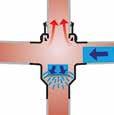
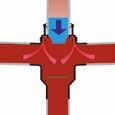

• Limits negative pressure by optimal venting and prevents self-siphonage
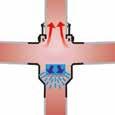
The single stack branch DN 100 main body is connected to the stack using standard couplings and a traditional jointing method. Their watertightness is ensured by the rubber gaskets which equip the S and Plus ranges offered by PAM Building.
The overall plumbing works shall be executed in compliance with standard EN 12056: the appliances shall be installed with traps in compliance with the specifications of the same standard.
The single stack branch exists as a long tai to allow connection to the main stack under the slab and thus facilitate installation either in new or renovation works. Three different products, 2 or 3 inlets:
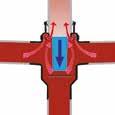
• Corner branch two inlets 88°
• Double branch two inlets 88°
• A consecutive branch, three inlets 88°
Rubber plugs with several pre-cut lids will allow one to three different connections.

The internal diameter of pipes cannot be reduced in the direction of the water fl ow, except in the case of pipework operating at full bore, under negative pressure such as in the EPAMS siphonic roof drainage system. The addition of branch connections, or changes of fall liable to increase the water flow rate, may require an increase in internal pipe diameter. This increase can be applied upstream of the new branch connection, using a tapered pipe (see p.98).

In horizontal and near horizontal pipelines, increases in size shall be installed so that the soffit is continuous, to prevent air from being trapped.


To secure roof watertightness, which is of crucial importance, the number of roof penetrations should be limited. PAM Building has designed a roof penetration device for its pipe systems that is watertight and quick to install.
The system was developed to facilitate the installation of completely watertight roof penetration for cast iron primary ventilation pipes or vent pipes. The flanged fittings clamp both the vapour barrier and the waterproofing layer.
The roof penetration device is a set of two ductile iron flanged fittings – one of the flanges is fixed, the second is movable – equipped with rubber gaskets. Rubber gaskets are available in EPDM or NBR quality where hydrocarbons may be present.
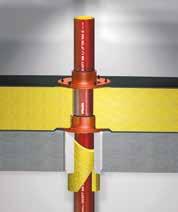


See product codes on p.103
The first flange fitting, installed above the roof, clamps the vapour barrier under the roof insulating layer, the second, above the insulating layer, clamps the waterproofing layer, whether it is polymer or bituminous.
Access to the pipework must be ensured so that tests, inspections and maintenance can be performed. Access may be obtained using a short access pipe.


On horizontal runs, the short access pipe will be installed in a slightly sloped position with respect to the pipe crown.


combines reliability, ease of use and operation safety:
The short
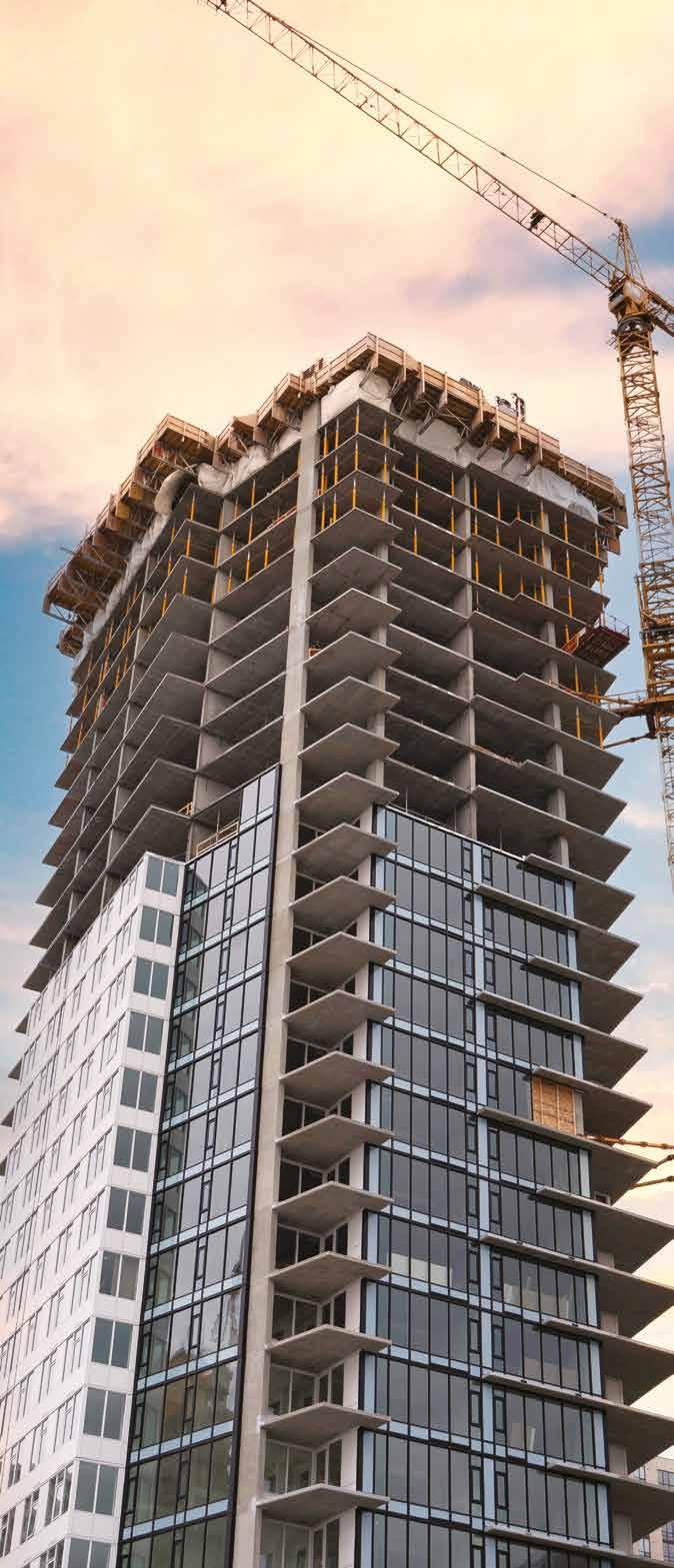
For cast iron, the bracketing system is designed to only carry the weight of the pipe and its content, which makes the specifiers’ design work easier.
Note: The technical specifications for threaded rods and metal brackets shall be established on this basis.
Bracketing recommendations for cast iron pipe system elements
Number of brackets
Consult local requirements for compliance
* For PAM-GLOBAL® pipes L ≥ 2.7 m installed outdoors - ** When the shape of the fitting permits it
It is also recommended to use one bracket per length or fitting (when the shape allows it, i.e. branches, etc.)
The general recommendation for horizontal pipework is two load bearing brackets per pipe.


As an indication, they should be installed 0.75 m from each spigot so that, ideally, the distance between two brackets is 1.5 m. Installation shall respect a slight fall, around 1 or 2%, and 0.5% as a minimum, (0.5 cm per metre).
For vertical waste or rainwater stacks, the brackets aim to prevent the pipework from falling over. It is recommended that one bracket be fitted for each floor level.
Ideally, the bracket should be installed on the first third of the upper spigot, and even closer to a socket joint.
At the bottom of the stacks, the forces from the pipe’s weight and possible end thrust efforts will preferably be addressed through stack support pipes.

The evacuation of waste, soil and rainwater generates structure-borne and airborne sound between rooms and usually occurs as a result of a mixed flow, when the pipe is filled with water and air. In such circumstances a pipe will radiate noise outwards and transfer it to any lightweight ceilings, cupboards and similar areas wherever it makes contact.
All brackets within the PAM Building range meet the requirements of the most demanding standards. For high levels of acoustic performance, the standard steel brackets fitted with a new acoustic dampener should be used. The different assemblies have been tested to EN 14366: Laboratory measurements of noise from wastewater installations. The PAM acoustic dampener has been developed to meet the increasing demand for buildings to have a high level of acoustic performance above regulatory requirements.
2 possibilities for fixing the PAM Acoustic Dampener on a Pipe Bracket:
1. Vertical lines: Each end of the acoustic dampener can be fixed to the bracket. For each 3 m of length minimum 1 pipe bracket must be used. For each pipe bracket 1 dampener must be used.
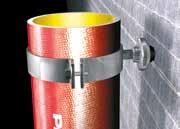
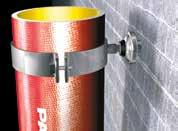
The weight of the pipes and the resulting water pressure must be absorbed by other devices: grip collars, stack supports, etc.
2. Horizontal lines: Each end of the acoustic dampener can be fi xed to the bracket. For each 3 m of length minimum 2 pipe brackets must be used. For each pipe bracket 1 dampener must be used.
With each type of fixation, the best effect can only be achieved if the components are neither deformed nor compressed.
Maximum horizontal load F per dampener: 100 daN.
1. Dampener – elastomer EPDM
2. M8-M10 – threaded nut; galvanised steel

3. Stainless steel housing, A2


4. Thread connection with 17 mm key value ; galvanised steel
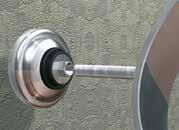
This mounting leads to rotation / torsion of the elastomer, which means the dampener cannot work properly and the elastomer might be cut. Therefore, this type of fixation is not allowed.
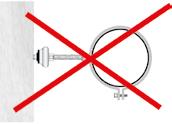
ATTENTION: This assembly causes the elastomer to twist
Pipework is subject to different forces liable to affect its stability. Stack supports are cast iron components designed to address these efforts.

On straight runs, stack support pipes should be installed to address the pipes' weight. At the bottom of the stack, the first stack support pipe addresses both the pipes' weight and the end thrust effort. For the last case, it is recommended that the support and fixings be adapted accordingly.
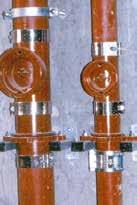
We recommend positioning the first stack support pipe at the base of the first floor, and then every subsequent fifth floor, in the case of a standard average 2.5 m between floors, or more generally every 15 m.
In the case of a wall or slab opening closed by mortar, thus constituting a fixed point, no stack support pipe is required.

The support bracket of the stack support is covered with a rubber gasket to limit the transmission of structure-borne noise emitted by the drainage network at slab level.
During laboratory tests carried out in 2019*, a stack assembly including a stack support pipe on a console support and a rubber-lined bracket, both fixed to a wall with a surface density of 220 kg/m2, showed slightly better results than the same installation made with two fixings with rubber-lined brackets. In this particular installation, the use of stack support pipes does not affect acoustic performance.
*Tests carried out according to standard EN 14366.

Admissible load for stack support console (see products on p.143)

Either on cantilever arms or stack support consoles up to DN 125.

Stack support pipe installed horizontally

A wall bracketing system is available in mild steel, for use with stack support pipes and brackets. Admissible load for cantilever arms (see products on p.142-143)




PAM Rapid Couplings (S and INOX)

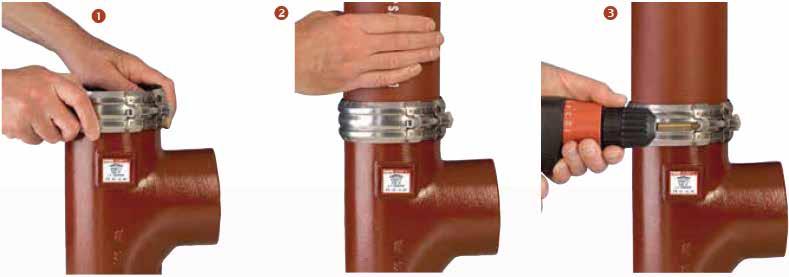
> DN 50 to 200
Couplings are supplied pre-assembled. The PAM Rapid from DN 50 to 200 is designed to be tightened to fully closed, there is no need to check the torque.
They can be assembled in two different ways, depending on whether an open strap is required.
Standard assembly:
1. Open the stainless steel strap.
2. Slide the stainless steel strap loose around the first pipe component.
3. Push the sealing gasket onto the component spigot so it abuts on the central register of the gasket.

4. Push the second component into the sealing gasket, so that it abuts on the central register.
5. Bring the steel strap over the sealing gasket.
6. Tighten the bolt with a ratchet spanner or a power tool applying the following tightening torque: DN 250 and DN 300 = 25 N.m.


Open strap assembly: An open strap is sometimes required to facilitate access: stack installation, etc.
1 - Push the rubber gaskets onto the spigot ends top and bottom, ensuring the central registers are abutted against each spigot edge.



2 - Twist the stainless steel strap to ease the wrapping around the pipe components.
3 - Clip the bolt and loosely assemble the coupling around the gasket.
4 - Check the alignment of the assembly before tightening the bolt with a ratchet spanner or a power tool, applying the following tightening torque: DN 250 and DN 300 = 25 N.m.
ATTENTION:
Wherever couplings may be subject to end thrust forces, they must be secured with grip collars. See p.152 for installation details.

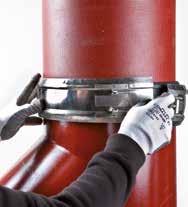
The easiest way to connect cast iron systems to other drainage materials is to use rubber connectors or plugs. Flexible couplings and stepping rings are also available to facilitate connections where variances in diameters have to be compensated for.



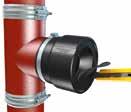


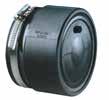
Rubber transition connectors PAM KONFIX and PAM KONFIX-Multi are used to connect waste pipes made from other materials (steel or plastics) to a PAM cast iron pipe system.
The plugs can be pierced to the appropriate groove from 32 mm up to 54 mm waste connections and the center disc torn out where required.



To connect PAM cast iron pipes with an outside diameter of 109-112 mm (tolerance range for PAM cast iron pipes DN 100) to other rigid materials with an outside diameter from 72-110 mm.
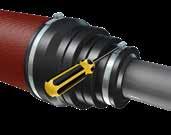
To connect PAM cast iron pipes with an outside diameter of 109-112 mm to waste pipes with an outside diameter up to 115 mm maximum. The connection is made with two hose clamps both suitable to address larger diameter tolerances.


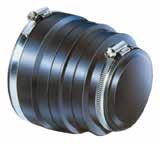
1. Push the open end of the PAM MULTIQUICK connector over the pipe end and place the hose clamp to its tightening position.
2. Then use a knife to cut open the pre-cut lid to the corresponding outside diameter of the connecting waste pipe. Then push the second hose clamp loose over the connecting rubber end.
3. Push the connecting pipe into the PAM MULTIQUICK connector and tighten the hose clamp in the right position. Ensure that the sealing zones (face ends of pipes or fittings) are clean: remove paint flakes and cement residues. The hose clamps should only be tightened manually with a screwdriver to avoid any damage to the PAM MULTIQUICK rubber connector.
PAM cast iron connections to other materials may often be required in new construction projects or for renovation. Different solutions can be used with products from our catalog (see figures below). Depending on the outside diameters, solutions exist for compensation. If you are unsure of the circumference of the material being connected, you can use a circumference tape. The range of tolerance of the different joints can help you find the required solution. The table below lists the solutions for connecting PAM cast iron to the most frequently encountered material.
*PAM Rapid can be used for type 1 installation but it may create an aesthetics default (stepping ring can exceed the width of the coupling).





The multi-waste manifold simplifies waste plumbing by grouping all associated pipework from various sources such as sinks, basins, bidets, urinals and showers to one internal point above the finished floor level. The manifold will permit the connection of three 32/38 mm copper/plastic waste inlets to any new or existing 100 mm diameter pipe stack and three 50 mm copper/plastic waste inlets to a 150 mm diameter pipe stack.
The manifold main body is connected to the stack using standard coupling. On the 100 mm manifold, to achieve a 32 mm waste connection, remove the 38 mm inner rubber ring by using the outer ring (for waste pipe maximum lengths see EN 12056-2). Pipework connecting discharge appliances to a manifold should be designed not to cause self-siphonage.
1. Cut the appropriate groove for 32 mm or 38 mm waste connections (100 mm manifold only), remove the grommet and tear out the centre disk where required.

2. Apply an appropriate silicone grease (not provided) to the outside of the grommet and re-fit into the manifold ensuring the retaining groove of the grommet is located correctly in the casing.
3. Lubricate the pipe ends and insert into the grommet with a rotational movement. Pipe ends may be chamfered for ease of insertion.



4. Any grommet not fitted with a waste pipe must also follow instruction 2 above.

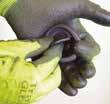


The Plus range pipes can be used in below-ground applications. Buried pipes are subject to mechanical strain due to the weight of the ground and possible wheel loading when laid under an area where traffic circulates.
The mechanical performance of buried pipework is to be considered like a pipe/soil system: the interaction of the pipes with the surrounding soils depends on their stiffness or flexibility, and the type of laying condition selected.
The choice of bedding and backfilling depends on the depth at which the pipes have to be laid, and the size and strength of the pipes. Standard EN 1610 “Construction and testing of drains and sewers” applies to drains normally buried in the ground and normally operating under gravity.
The hypothesis for rigid pipes retained for the calculation of admissible depth of cover is set out below.
Installation parameters are established according to:
• Soil type (see groups below)
• Quality of compaction of the embedment

• Behavior of the pipe (rigid for cast iron)
• Presence of wheel loads or not
• Particular conditions (groundwater table, etc.)

Backfilling recommendations from DN 100 to DN 300, with or without traffic loads (according to EN 1610)
Two main solutions have been retained from the EN 1610 recommendations, taking into account both ease of installation and knowledge from experience of rigid pipe systems. For compaction, the most adverse hypothesis was retained.
These solutions maximise the advantage obtained from cast iron’s mechanical properties: depth of cover it can withstand, possible backfilling with native soil removed, thereby limiting damage to the environment, etc.
Case no.1
Case no.2
Based on our experience in buried pipe systems and the French origin of our company, we have applied the French Fascicule 70 calculation model (recommendations for sewage pipe systems according to the pipe material).
The table below gives values for depths of cover according to the Fascicule 70 calculation, considering rigid pipes.
** Does not take into account the frost-free arrangements.
(1) The calculation allows shallower depth of cover, but this figure includes a safety margin / ground surface proximity and related hazards.
• Clearance at each joint between the couplings and the granular bed to allow sufficient space, and to prevent the pipe from resting on the joints. (see EN1610 §6.5)

• Testing for pipe system leak tightness according to EN 1610 §12

• Identification of the pipework with a netting for example
• Furthermore, check that these specifications do not contravene other local or national regulations or recommendations for installation
For any other case, other diameters or buried systems under the bottom slab, please contact our technical support team: tcbatiment.sgpam@saint-gobain.com - Tel:+33 (0)3 66 74 00 89
Where the pipe system is to be set in concrete, a minimum 2.5 cm width of concrete on every side has to be respected because during and after its curing, the concrete will be subject to shrinkage and carbonation.
To reduce the natural rigidity of the concrete and its strain, a suitable flexible joint can be installed at intervals. This could be made of a compressible material (e.g. expanded polystyrene), be placed next to a pipe joint, and conform to the full cross section of the concrete. (See Fig). Refer to local best practice.

Furthermore, the pipe system should not be in contact with the concrete's metal reinforcements.
Surround should not be carried out until the pipework has been tested and inspected.
The system is under French Technical Approval 5.2/14-2386_V2 CSTB.
1. No rain
2. Rainfall starts at low intensity – Drainage is performed by gravity flow
3. Continuous flow is achieved according to the rainfall intensity and roof area drained

4. Rainfall intensity increases to the maximum DRI–Flow continues by gravity until the maximum value is reached
5. No more air entering the system – Kinetic and pressure energies enhance the absorbing capacity quickly to the maximum design flow rate
6. Rainfall intensity stabilises to max. value => absorbing siphonic flow rate is maintained
7. Rainfall intensity decreases – Flow comes back to gravity system
8. Rainfall intensity stabilises to low value => absorbing gravity flow rate is maintained
9. No more rain – the rooftop surface is emptying
A siphonic roof drainage system is truly an «engineered system» which must be designed with careful and expert analysis. The pipework design is the key factor for performance and operational safety.
PAM Building sales staff, trained in the EPAMS® system, first evaluate your roof drainage project. When feasibility is confirmed, a technical team designs both the technical study and network sizing using the dedicated EPAMS® software.
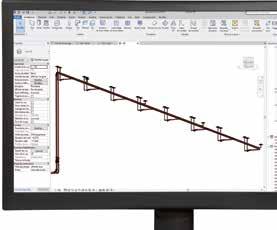
The system must always be properly balanced and the flow velocity controlled. To protect the lifespan of the EPAMS® siphonic systems, the PAM Building design maintains that the dynamic pressure within the system should never exceed 5 bar.
Trained staff specifically in charge of your design will handle your siphonic project until the work’s acceptance; each change to the plans results in the need for a new study.
Before the acceptance of the work, PAM Building or a delegated third party checks on site that the installation fully complies with the last study isometric drawings; any modification to an EPAMS® pipework route at the installation stage requires further approval from PAM Building.
This thorough management of the EPAMS® projects – feasibility study, project follow-up and control after installation completion – ensures the EPAMS® system’s efficiency and provides the project manager with total peace of mind.
The EPAMS® outlets are easy to install. The installation has to be done in accordance with best practice and the Technical Approval requirements.
PAM Building EPAMS® 100% metal outlets fully guarantee mechanical strength and durability. They fully comply with EN 1253 on each specific point: flow capacity, watertightness, solidity, mechanical strength, heat resistance and climatic stresses (resistance to UV radiation).
The grating and anti-vortex mechanism are made in one piece. This allows quick removal with no risk of mistakes at reassembly, easy intervention and maintenance.


An EPAMS® pipework consists of one or several horizontal pipes without fall connected to a downpipe: horizontal runs and stacks are made of S range cast iron components. The joints are generally made with PAM Rapid or equivalent couplings.
• Connection of the roof outlets to the pipe system: Depending on the job site constraints, the connection can be made flat or vertical.
The EPAMS® outlets are made of 3 different parts:
• The Anti-Vortex mechanism, aluminium grating. Bolted on the bowl, it is the same for all the outlets.
• An identical stainless steel bowl for all the outlets, on which different components can be assembled depending on the field of use.
• A stainless steel tail available in four DN: 50 – 75 – 100 – 125.
• Decompression zone:
Before connecting to the sewer main, siphonic systems have to run by gravity again.
At the end of the downpipe, the bottom pipe increases in diameter – generally two extra diameters – causing decompression and reducing the flow velocity.
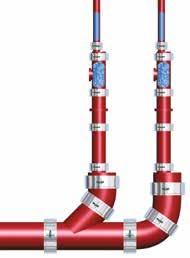
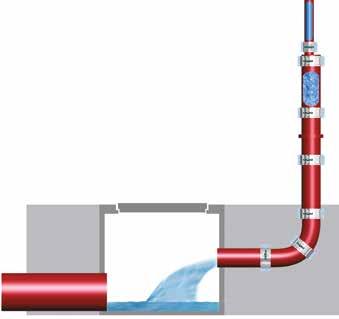

Case no.1
Vertical decompression zone in the last metre of the stack
Tapered pipe reducer
Short access pipe
Stack support pipe
Tapered pipe reducer
Gravity bend
Manhole cover
Case no.2
Decompression zone directly connected to a manhole
If the manhole is connected close to the stack, the short access pipe is optional. The potential high discharge rates shall be taken into account for the manhole sizing.
Stack support pipe
Case no.3 Horizontal decompression zone
This solution must be considered before the design study.
Short access pipe
Stack support pipe
Tapered pipe reducer
Tapered pipe reducer
Gravity drain
• Pipe support
Stack support pipes are installed at the bottom of stacks to address forces due to changes in the stream flow systems. Every 15 metres is the general requirement.
• Pipe brackets:
Owing to the high discharge rates, rubber-lined steel brackets are compulsory. Two brackets per pipe length shall be installed for horizontal or vertical pipework. It is also recommended to use one bracket per length or fitting (when the shape allows it, i.e. branches, etc.).
For the EPAMS® siphonic system, only round full and rubber-lined brackets shall be used.
For brackets fixed to plain threaded rods, the distance between the bearing structure (concrete slab, steel frame, etc.) and the axis of the pipe shall not exceed 500 mm. If this maximum distance cannot be respected, the rigidity of the fixings should be increased (triangulation, steel knee brace).
Check local requirements for compliance.
• Gripped couplings

On EPAMS pipework, grips collars are specified on couplings where they will withstand dislocation forces.


- Horizontal pipe connected to the outlet when the expected pressure is over 0.5 bar or -0.5 bar.
- The negative pressure will be highest at the head of the stack (down to -0.9 bar); the couplings there will be systematically installed with grip collars.
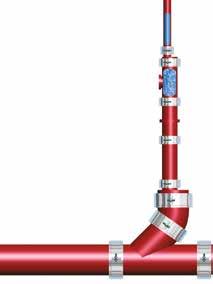
- Change of direction: at changes of direction on stacks and low collectors, the couplings will be gripped. Where a change of direction will be added or removed, PAM Building will carry out a new study taking the new head loss into account.
- The decompression zone is subject to turbulences, and subsequently, every component at the bottom of the stack, before the return to the gravity flow system, will be gripped.
Number Pipe length > 2 m 2 Pipe length < 2 m 1 Fittings* 1
Tapered pipe reducer
Short access pipe
Stack support pipe
Tapered pipe reducer
Gravity bend
EPAMS®
Achieving balance of potential energy and head losses on the pipework can require a reduction in the nominal diameters to increase head losses.




The regulations state that reducing the nominal diameter (DN) of discharge pipes is prohibited in the direction of flow except for siphonic systems like EPAMS® (EN 12056-3 § 7,6,5) where it could be useful to control the pressure level. Increases and reductions of nominal diameters are made with the tapered pipe reducer. On horizontal runs, the pipe reducer will be installed so that the pipe invert is continuous.
The Technical Approval recommends they should be cleaned at least twice a year.
Any element like plant matter (leaves, twigs, etc.) or debris from the surroundings can end up on rooftops, and mustbe regularly cleared away to prevent clogging of the pipework or EPAMS® outlets. Maintenance cleaning frequency will largely depend on the building's environment. For buildings surrounded by trees and gardens, inspections will be done more frequently and the maintenance rate will be higher than the standard twice yearly requirement.
For all types of roof outlets, the cleaning process must be carried out as described opposite.





Cast iron pipe systems for drainage mainly consist of spigot pipes - generally supplied in 3 m lengths - and fittings of various shapes (bends, branches, etc.). The cast iron pipes can be cut to length. Where pipes are cut on site, ends shall be cut clean and square with burrs removed, and then re-coated with the adequate EXTREM 1 touch-up paints (see p.145), or other repair products recommended by PAM Building.
Pipes can be cut easily and quickly using either of the following methods. Cutting procedures must comply with the safety guidelines provided in the cutting tool manufacturer’s operating manual.
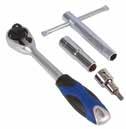

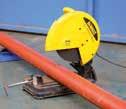
The Exact saw : the ultimate and fast solution for cutting 50-200 mm cast iron (see p.144)
• Easy, secure and effortless cutting for use on construction sites
• Wide range of applications and dimensions
• No rework necessary – accurate cutting
• Suitable for clamping joints
• Reduction in tool costs
• Reduction in sparks – may not require hot works permit

Pipe ends needed to be recoated with touch-up paint.

We recommend protecting the cut ends with EXTREM 1 (see p.145), a new quick drying touch-up paint that air dries in 15 minutes.
The acrylic paint on the pipes is a primer which can be over painted with most top coats. Finishing paint is needed where the pipework is visible, indoor or outdoor. What types of paint can be used? Any alkyd resin or glycerophtalic paint designed for metal care and suitable for the requirements of the local environment.
The system should be gently rubbed down with suitable abrasive paper to provide a good adhesion key for the finishing coating. Where the finishing paint is to be used onzinc-coated pipes to rejuvenate them, rub them down gently to remove possible zinc salts.
Where incipient rust has already appeared on cast iron products, corrosion inhibitors can be used before painting. Some existing metal finishes, including anti-corrosive pigment, can be applied directly to rust.

Typical example of a spigot system
1. Measure the length of the branch, adding a further 15 mm in total to allow for the coupling’s central register top and bottom.
2. Make sure existing pipework is adequately supported from above.
3. Mark the pipe position for cutting.
4. Cut the pipe using a powered disc cutter or wheel cutter and remove sharp edges.

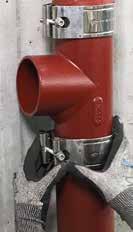
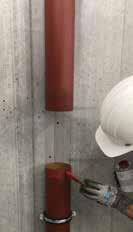
5. Coat the cut ends with the appropriate touch-up product (epoxy coating).
6. Push the rubber gaskets onto the spigot cut ends top and bottom, ensuring the central registers are abutted against each spigot edge.
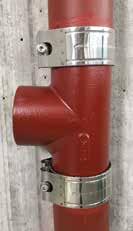



7. Position the fitting in the stack within each rubber gasket abutting against the central registers.
8. Loosely assemble the coupling around each gasket.
9. Check alignment of assembly before tightening the bolts to the recommended level, depending on the coupling's technical recommendations.
10. Test the new stack for successful joints.
For more information please contact our technical department: e-mail: tcbatiment.sgpam@saint-gobain.com tel: +33 (0)3 66 74 00 89
For the dimensioning of rainwater and wastewater systems, the nominal sizes can be determined using the dimensioning tables in the appendix of DIN EN 12056. These tables only represent the discharge capacity of the smallest permissible inner diameter of the values specified.
If the pipe material is known at the latest during the execution planning, the specific discharge capacities should be determined for a differentiated calculation on the basis of the actual internal diameter of the respective drainage pipe system should be used for a differentiated calculation.
LEVEL H/D = 1.0 WITH SLOPE 1 cm/m

(see also J cm/m in the following table)
CALCULATE THE SLOPE:



These Terms and Conditions of Sale (“T&Cs”) cancel and replace those previously communicated. They apply to any order placed by a client (“Client”) to SAINT-GOBAIN PAM BÂTIMENT, a company organized and existing under the laws of the French Republic with a share capital of 6 812 970,75 € with its registered office at 21 avenue Camille Cavallier in Pont-à-Mousson (54700), France registered with the Register of Commerce of Nancy under number 799 283 882 (“PAM BUILDING”), for the sale of PAM BUILDING’s goods and services (“Products”).
Any order made by the Client implies its adherence to these terms and conditions of sale. The Client’s purchasing conditions shall not take precedence over these terms and conditions of sale unless first agreed in writing by PAM BUILDING. Any prior written acceptance of the latter by PAM BUILDING may only be intended, where applicable, to supplement these conditions in the event of their silence.
PAM BUILDING reserves the right to amend its T&Cs at any time, the applicable T&Cs being those in force on the date of the order sent by the Buyer.
2.1 - Each order for Products must be identified as an order and must include the necessary information for its processing, in particular sufficient accurate information on the branding, delivery and listing of the range, in order to allow PAM BUILDING to process this order as best possible. In case of insufficient or inaccurate information, PAM BUILDING may delay the shipping date of Products, without prejudice to any other solution.
2.2 - Orders do not become firm and final until PAM BUILDING has issued an acknowledgement of receipt. No modification or cancellation of an order shall be taken into account after the issue of the acknowledgement of receipt of the order.
Unless otherwise provided between the parties, PAM BUILDING’s silence does not constitute acceptance of an order.
3.1 Products are sold under the conditions and for the prices currently applicable on the effective delivery date or, where there is an offer, the prices indicated in relation to it, insofar as the order is received by PAM BUILDING within the period of validity of that offer.
3.2 Where PAM BUILDING issues an offer, prices are firm throughout the duration of the offer or for a maximum duration of two (2) months following the issue date of that offer. After this period, price increases may be applied.
3.3 Prices may be modified by PAM BUILDING at any time with a notice period of thirty (30) days.
3.4 Unless specifically agreed, prices are expressed in euros, net, excluding VAT. If applicable according to the Products destination, these prices are billed after application of value added tax at the rate in force. PAM BUILDING shall be entitled to recover any tax, duty or increase arising from a change to regulations or legislation, from its entry into force.
4.1 Our delivery times are mentioned as an indication, and correspond to our best estimate. Delivery times are only firm when they are expressly classified as such in the order acknowledgement.
4.2 Non-respect of the indications relative to the delivery time does not authorise the Client to cancel their order, to delay payment beyond the agreed conditions or to withhold or offset any part of it.
4.3 No late penalty may be claimed from PAM BUILDING if it has not been expressly agreed with regard to its principle and its terms in the order acknowledgement.
4.4 PAM BUILDING is not responsible for breached delivery times where:
> the Client has not respected the payment conditions; or
> where information to be provided by the Client has not arrived within the required time;
4.5 The transfer of ownership of the Products to the Client is conditional upon payment of the price in full.
4.6 Risk is transferred under the conditions defined by the chosen Incoterm (Incoterms published by Paris International Chamber of Commerce in force on the effective delivery date, the “Incoterms”) or where Products are customised and covered by the carrier.
4.7 In the absence of specific conditions agreed beforehand and confirmed in the order acknowledgement by PAM BUILDING, the Products are sold Free Carrier (FCA - Incoterms® 2020) from PAM BUILDING’s shipping site.
4.8 For any exit from the European Union territory made by the Client or the forwarding agent designated by the Client, as proof of exit, the Export Control System (“ECS”) of exit must be sent to PAM BUILDING. In the event that the ECS cannot be provided, the Client or its forwarding agent may send to PAM BUILDING, the Bill of lading for shipment by sea or the Airway Bill for shipment by air or the CMR Way Bill with receiver’s signature and stamp or the Delivery note with receiver’s signature and stamp.
5.1 Products are inspected in the factory according to PAM BUILDING’s quality control procedures and the standards in force.
5.2 In cases where a special inspection has been agreed, by the Client or an organisation representing it, the inspectors in charge are advised of the dates and times in which inspections must normally take place.
6.1 Where the Client organises transport itself, it assumes the restrictions of adapting vehicles to Products and the obligation to make an appointment 48 hours in advance. Otherwise, the delivery cannot be loaded.
6.2 The Client is responsible for unloading operations carried out under its control. In this regard, the Client must ensure respect for safety conditions on site and provide suitable means to allow unloading in the best possible safety conditions. In particular, in case of a delivery by truck crane, the Client shall assist the driver by separating pipes and packages on the ground. The Client must establish a safety protocol with the carrier prior to unloading.
6.3 In case of lost, damaged or missing Products observed upon delivery, the Client shall take recourse against the carrier, stating its reservations on the transporter’s delivery form. It will confirm these reservations with the carrier, by registered letter with acknowledgement of receipt, addressing its claim with supporting documentation within 3 business days following receipt of the Products.
7.1 Unless otherwise indicated, payments are made at the address stated on the invoice, within forty-five (45) days from end of the month following the invoice issue date, independently from the date of receipt of the Products by the Client.
7.2 Drafts accepted must be returned within 10 days following their issuance. This deadline also applies to means of payment issued by the Client.
7.3 Any payment made after the payment date stated on the invoice shall allow the billing of (i) late penalties at a rate equal to the interest rate applied by the European Central Bank to its refinancing operation plus 10 percentage points and (ii) a fixed charge for recovery costs, of a sum of €40; PAM BUILDING reserves the right to seek additional compensation, upon justification, in the event that its recovery costs exceed this amount.
7.4 In case of non-payment of an outstanding invoice, all of the invoices in arrears shall become immediately payable. In addition, PAM BUILDING reserves the right to suspend orders in progress, without prejudice to damages and interest.
7.5 No claim by the Client may invoke the modification, delay or suspension of payments due, or authorise it to offset or deduct payments against those owed to PAM BUILDING. Any offsetting or deduction not agreed beforehand shall constitute a payment incident justifying the application of the above measures.
7.6 In the event of a significant change to the Client’s legal or financial situation, affecting PAM BUILDING’s assessment of its solvency, or in case of an excessive outstanding amount, PAM BUILDING reserves the right even after partial execution of an order to either demand guarantees or cancel the outstanding orders.
8.1 Without prejudice to the measures to be taken with regard to the carrier, claims in relation to the non-conformity of delivered Products with those listed on the order acknowledgement must be submitted in writing within 3 days from receipt of the Products. After this time, no claims shall be accepted.
8.2 PAM BUILDING guarantees the Client against hidden defects that may affect the sold Products. If the Client detects a manufacturing fault in the Product, in its opinion constituting a hidden defect, it must send a claim to PAM BUILDING immediately.
8.3 The implementation of the guarantee for conformity and hidden defect is conditional upon these faults being jointly observed and acknowledged as effectively attributable to PAM BUILDING. The Client will provide all justifications as to the reality of the faults found. It shall facilitate PAM BUILDING in observing these faults and remedying them. The Client shall abstain from interfering with the Products.
8.4 An observation of the fault will then be conducted, within 1 month -with everything as is, except in case of force majeure - in a report in the presence of PAM BUILDING’s representatives.
8.5 If the existence of a fault is jointly found and recognised by PAM BUILDING as being effectively attributable to it, PAM BUILDING shall assume the repair of the Product or supply a replacement of the Product previously delivered, and the corresponding shipping costs.
8.6 The Client is obliged under its exclusive responsibility to respect the indications given by PAM BUILDING as well as the industry standards for the compliant handling and use of the Products as well as all technical instructions.
8.7 The guarantee given is excluded in case of:
> apparent defect, or that which a professional would discover;
> defect and/or deteriorations caused by natural wear or by an external accident;
> modification of the Product not provided for or specified by PAM BUILDING;
> defect and/or deteriorations caused by a compatibility fault against Products not provided by PAM BUILDING;
> non-respect by the Client of the indications concerning handling, fitting, use and maintenance of Products as well as industry standards; > force majeure or similar event.
8.8 The guarantee given by PAM BUILDING is for 12 months from delivery. Interventions conducted in relation to the guarantee shall not result in extending this period.
9.1 PAM BUILDING warrants that its Products comply with their specifications at the date at which they are placed at Client’s disposal. Specifications, performances and technical characteristics stated in catalogs, technical brochures and any other commercial documentation and packaging are subject to revision at any time without any prior notice to the Client. Characteristics and colours of PAM BUILDING’s Products have an indicative value due to their nature of manufacturing.
9.2 Client recognizes that he is aware of the technical characteristics of the Products as well as their conditions of use and application, defined in particular by the rules of the art and the current technical documentations. For the avoidance of doubt, the Client shall conduct prior and sufficient tests to verify that the Products meet its requirements.
9.3 PAM BUILDING’s liability is limited to the supply of the Products complying with PAM BUILDING’s specifications to the exclusion of any consequence of an improper, careless or inadequate use which remains under the exclusive responsibility and liability of the Client.
9.4 PAM BUILDING’s liability is limited to the replacement or reimbursement of the Products proved to be defective, without indemnification or compensation relating to transport or labour costs to be due to the Client. No responsibility or liability shall be accepted for any statement, representation, warranty or otherwise made by any of PAM BUILDING representative, agent or distributors.
The plans, models, studies, results of trials, catalogs, notices and all commercial and technical documents disseminated on any support whatsoever, by PAM BUILDING are the exclusive property of PAM BUILDING. As a result, the Client is prohibited from making any copy whatsoever without PAM BUILDING’s prior agreement.
11.1 The weights and dimensions of Products indicated on PAM BUILDING’s documents are theoretical in value. PAM BUILDING reserves the right to make any modification to the information given in its documentation.
11.2 The documents regarding the handling, storage, fitting, use and maintenance of Products are provided by PAM BUILDING free of charge, at the Client’s request. The Client remains solely responsible for compliance with the health and safety conditions of these various operations and the implementation of the Products according to industry standards.
PAM BUILDING reserves the right to modify the data given in its documentation at any time. It is the Client’s responsibility to verify their validity with PAM BUILDING.
12.1 The Products’ packaging is designed so as to satisfy the requirements of transportation.
12.2 Packaging and dunnage not billed for by PAM BUILDING will be recovered upon delivery.
The Client undertakes to respect all applicable laws, particularly those concerning export controls. If, at any time, a new law or regulation enters into force rendering the execution of PAM BUILDING’s obligations impossible or illegal, PAM BUILDING shall be entitled to cancel the order and terminate the contractual relationship, without any liability with regard to the Client.
14.1 PAM BUILDING, as a controller, carries out a computerised processing of its clients personal information to place orders and make deliveries.
14.2 Personal information collected in this context
(Client’s company name, first and last name of PAM BUILDING’s contact at the Client’s, email address, business telephone or fax number) is
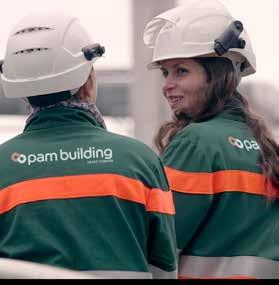
strictly necessary for the T&Cs execution and enable PAM BUILDING to manage the order, delivery, invoicing and collection.
14.3 Personal information is kept for the entire duration of the commercial relationship and within the limits of the applicable laws.
14.4 PAM BUILDING’s customer service, commercial, invoicing and collection departments, as well as its subcontractors responsible for delivery and sending invoices, receive this data.
14.5 In accordance with applicable regulations regarding personal information protection, the Client has a right to access, to correct, to erase and to object to the use of his or her personal information, which the Client may exercise, by sending an email to: privacycontact.sgpambatiment.fr@ saint-gobain.com, or by writing to : SAINT-GOBAIN PAM BÂTIMENT – Privacy Correspondent – 21 avenue Camille Cavallier, 54700 Pont-à-Mousson, France.
14.6 For more information about the way PAM BUILDING processes personal information, the Client may consult the web page «Your data and your rights» on PAM BUILDING’s websites: www. pambuilding.fr (France website) and www.pambuilding.com (Export website).
14.7 If the Client considers, after having contacted PAM BUILDING, that his/her rights are not respected or that the processing of his/her personal information by PAM BUILDING does not comply with the applicable rules, the Client shall be entitled to file a claim with the French personal data protection supervisory authority (CNIL).
The Client undertakes not to disclose to a third party, in whole or in part, any document, data, or
information exchanged, in any form and of any nature whatsoever relating to the order and/or the Products without the prior written consent of PAM BUILDING. This commitment shall apply for the entire duration of the order and for five (5) years from the last delivery of Products under said order.
16.1 PAM BUILDING is not responsible for cases of force majeure. Force majeure is understood to mean any cause independent of the will of PAM BUILDING, which would render the performance of its contractual obligations impossible, and affect the manufacture, shipping and delivery of Products. Cases of force majeure are considered to include disruptions to production and/or delivery resulting from a war (declared or not), strike, lock-out, accident, fire, flooding, natural disaster, epidemics, pandemics, interruption or delay in delivery, shortage of materials and/or raw materials, embargoes, and settlements, of any nature whatsoever.
16.2 In the event of force majeure, PAM BUILDING shall have a reasonable extra period of time in which to execute its obligations.
In the event of a dispute as to the formation, performance or interpretation of the sales contract, the Nancy courts shall be solely competent even in case of multiple defendants, guarantee claims or proceedings in chambers. These T&Cs shall be subject to French law to the exclusion of its conflict-of-law rules.
100% PAM Building System - 100% Guaranteed Performances
Only the exclusive combination of PAM Building products (pipes, fittings, couplings) and

the respect of the implementation rules guarantees you results in accordance with the test reports from PAM Building and allows you to benefit from the 10 years warranty.

Photos: DR, ©Istock, ©Shutterstock, ©Saint-Gobain PAM Bâtiment. All rights reserved
• The photos and illustrations used in this document are not contractual. Any reproduction, even partial, of the diagrams, photos and texts in this document is prohibited without the authorization of Saint-Gobain PAM Bâtiment (Law of March 11, 1957). Realisation: Delicate essence www.delicate-essence.fr